Sites: news | india | latam | brasil | indonesia
Feeds: news | india | latam | brasil | indonesia
topic: Lizards
Social media activity version | Lean version
New ecoregion proposed for Southern Africa’s threatened ‘sky islands’
- A group of scientists is proposing the designation of a new African “ecoregion” consisting of an “inland archipelago” of 30 isolated mountains, some harboring animals and plants found nowhere else on Earth.
- The South East Africa Montane Archipelago straddles southern Malawi and northern Mozambique.
- This geographical isolation has fueled the evolution of separate species within the forests that grow on them, and those forests are now severely threatened by charcoal production and agriculture.
- It’s hoped the designation of a new ecoregion encompassing these mountains will promote nature conservation on a landscape-wide scale.
Photos: Top species discoveries from 2023
- Scientists described a slew of new species this past year, including an electric blue tarantula, two pygmy squid, a silent frog, and some thumb-sized chameleons.
- Experts estimate less than 20% of Earth’s species have been documented by Western science.
- Although a species may be new to science, it may already be well known to local and Indigenous people and have a common name.
- Many new species of plants, fungi, and animals are assessed as Vulnerable or Critically Endangered with extinction as soon as they are found, and many species may go extinct before they are named, experts say.
For Vietnam’s rare reptiles, lack of captive populations may spell doom
- As an epicenter of biodiversity, Vietnam hosts a wide array of reptile species. But new research shows that many species that occur nowhere else on the planet are poorly known and lacking protection.
- The researchers also found that many of Vietnam’s rarest species are absent from the world’s zoo collections and conservation breeding programs, risking their disappearance forever should their wild populations collapse.
- They call on conservationists and authorities to focus on conservation measures to protect the country’s most vulnerable reptiles, including establishing assurance populations that could be used in the future to repopulate areas of wild habitat from which they have been lost.
Newly described gecko from Madagascar a master of disguise
- Madagascar is a hotspot for gecko diversity, and the latest to appear on the tree of life is Uroplatus garamaso.
- U. garamaso, with a length of 8.3-13.9 cm (3.3-5.5 in), is one of the larger leaf-tailed lizards inhabiting the island, but is still a master at hiding in plain sight.
- The gecko’s known range is restricted to the forests in the north of the island: Montagne des Français, Montagne d’Ambre, and Ankarana in the Diana region.
Nepal’s BP Highway threatens endemic, critically endangered lizard
- The dark sitana, a lizard endemic to a town in Nepal, is critically endangered by the loss and degradation of its habitat due to the BP Highway and unplanned urban development.
- Researchers are studying the ecology and threats of the dark sitana and conducting conservation outreach to raise awareness and support for its protection among local communities and stakeholders.
- The dark sitana is understudied and neglected by the government and needs more research and conservation efforts to prevent its extinction, researchers say.
Six newly described chameleon species reflect Tanzania’s Eastern Arc Mountains’ fragility and richness
- Six new species of pygmy chameleon have been described from Tanzania’s Eastern Arc Mountains.
- The mountain forests are subject to intense human pressure, threatening the diverse plant and animal species that live in them.
- A recent study using satellite imagery discovered that in one district alone, 27% of its montane forests were lost to small-scale farmers and herders between 2011 and 2017.
- The Tanzanian government is currently working to increase agricultural production in a region that overlaps with the Eastern Arc Mountains, raising fears this will be at a cost to biodiversity.
Rumors and misconceptions threaten tokay geckos in Bangladesh
- Widespread misconceptions about the medicinal benefits of tokay geckos are leading to these common nocturnal lizards being hunted across Bangladesh.
- Wildlife traffickers set an exorbitant price on trapped geckos, based on rumors about their international demand. There is no documented evidence that buyers pay a high price for geckos.
- In the last five years, more than 250 geckos were recovered and more than 30 suspected wildlife smugglers arrested. In Bangladesh, a study found that gecko populations are estimated to have declined by 50% due to trade on the international market based on claims that the species holds medicinal qualities.
- Tokay geckos maintain ecosystem balance by preying on invertebrates, including moths, grasshoppers, beetles, termites, crickets, cockroaches, mosquitoes and spiders.
Top 15 species discoveries from 2022 (Photos)
- A resplendent rainbow fish, a frog that looks like chocolate, a Thai tarantula, an anemone that rides on a back of a hermit crab, and the world’s largest waterlily are among the new species named by science in 2022.
- Scientists estimate that only 10% of all the species on the planet have been described. Even among the most well-known group of animals, mammals, scientists think we have only found 80% of species.
- Unfortunately, many new species of plants, fungi, and animals are assessed as Vulnerable or Critically Endangered with extinction.
- Although a species may be new to science, it may already be well known to locals and have a common name. For instance, Indigenous people often know about species long before they are “discovered” by Western Science.
An elusive lizard thought to live only in India makes an appearance in Nepal
- Researchers have confirmed the presence of the Sikkim grass lizard in eastern Nepal, nearly 100 kilometers from its known range in India’s Sikkim state.
- The species was last year classified as endangered on the IUCN Red List because of its limited distribution and threats to its habitat from farming and a hydropower dam.
- Herpetologists say the discovery should prompt more research into Nepal’s little-studied reptile and amphibian life, with the potential for more species coming to light.
‘No’ to corporate-driven tourism development in Komodo National Park (commentary)
- Plans to build tourism resorts inside Indonesia’s Komodo National Park, home to the world’s biggest lizard, have for years faced pushback from local communities.
- Opponents of the projects point to the potential for ecological and social disruptions.
- Instead of tourism based on corporate investment, the government should develop a model of community-based tourism, argues Venansius Haryanto, a researcher at Sunspirit for Justice and Peace, an advocacy group based in Labuan Bajo.
- This article is a commentary. The views expressed are those of the author, not necessarily of Mongabay.
Top 15 species discoveries from 2021 (Photos)
- Science has only just begun to find and describe all of the species on Earth; by some estimates, only 20% have been described.
- This year, Mongabay reported on newly described species from nearly every continent, including an Ecuadoran ant whose name broke the gender binary, an acrobatic North American skunk, an Australian “killer tobacco,” a fuzzy orange bat from West Africa, tiny screech owls from Brazil, and more.
- Though a species may be new to science, that doesn’t mean it has not yet been found and given a name by local and Indigenous communities.
Color-changing robo-chameleon showcases promising camouflage tech
- A robot modeled on a chameleon and developed by South Korean researchers can change colors to match its surroundings.
- Like real chameleons, the robo-chameleon collects information from its environment in real time, but the way it reproduces the colors on its artificial “skin” is different.
- The researchers say they hope the system will in future be able to read and mimic patterns as well.
- If colors and patterns can both be replicated in real time, it could pave the way for clothing that essentially makes the wearer invisible.
Hold the scuba: These lizards can breathe underwater
- Researchers recently discovered that several species of semi-aquatic anole lizards can breathe underwater — or rebreathe — for up to 18 minutes.
- They observed that anoles have hydrophobic skin that allows a thin layer of air to form around their bodies when they dive underwater, which they believe aids their rebreathing process.
- When the anoles exhale underwater, a bubble of air forms over their snout and then goes back into their nostrils when they inhale.
- The researchers believe that anoles evolved to rebreathe underwater to avoid predators, although more research is needed to confirm this.
Reptile traffickers trawl scientific literature, target newly described species
- The descriptions and locations of new reptile species featured in scientific literature are frequently being used by traders to quickly hunt down, capture and sell these animals, allowing them to be monetized for handsome profits and threatening biodiversity.
- New reptile species are highly valued by collectors due to their novelty, and often appear on trade websites and at trade fairs within months after their first description in scientific journals.
- In the past 20 years, the Internet, combined with the ease and affordability of global travel, have made the problem of reptile trafficking rampant. Some taxonomists now call for restricted access to location information for the most in demand taxa such as geckos, turtles and pythons.
- Once a new species has been given CITES protection (typically a lengthy process), traders often keep the reptiles in “legal” commercial circulation by making false claims of “captive breeding” in order to launder wild-caught animals.
Newly described chameleon from Madagascar may be world’s smallest reptile
- A newly described chameleon from Madagascar is the world’s tiniest chameleon, and possibly the smallest reptile.
- A male specimen of Brookesia nana measured a mere 14 mm (0.55 inches), small enough to perch on an aspirin tablet.
- Madagascar hosts more than 100 species of chameleons, and 30 species belonging to the Brookesia genus alone.
- Many of the chameleons, including B. nana, are only found in tiny patches of forest that are severely threatened by deforestation and degradation.
‘Race against time’: Saving the snakes and lizards of Brazil’s Cerrado
- Brazil’s Cerrado is among the world’s most biodiverse savannas, covering two million square kilometers (772,204 square miles), nearly a quarter of the country and half the size of Europe.
- Once thought of as a “wasteland,” scientists have counted 208 snake species, some 80 lizards, 40 worm lizards, seven turtles and four crocodile species — many recently logged in the biome’s grasslands, palm-covered riverscapes, lowland forests and dry plateaus.
- But half of the Cerrado’s natural vegetation has been lost to mechanized agribusiness and ranching, with native plants and wildlife also at risk from climate change, and more frequent and intense fires. Today’s biome is fragmented, with just 3% under strict protection, and another 5% “protected” in farmed, inhabited mixed-use areas
- While researchers agree that there is an urgent need to protect large swathes of remaining savanna, there is also a vital requirement to preserve patches of unique habitat where diverse, niche-specialized reptilians make their homes.
Land grab, logging, mining threaten biodiversity haven of Woodlark Island
- Woodlark Island lies off the coast of Papua New Guinea and is home to dozens of unique species and a more than 2,000-year-old human culture.
- A recent court ruling has seen the land rights granted to Woodlark islanders in 2016 revoked and returned to an agricultural company that in 2007 planned to transform 70% of the island into oil palm plantations.
- Meanwhile, the status of an application submitted to the PNG Forest Authority by a logging company to clear 40% of the island under the guise of an agricultural project remains unknown, despite an ongoing petition signed by more than 184,00 people.
- A mining company has also started expanding infrastructure and clearing forest in preparation for a long-planned open-pit gold mine, but has faced backlash from villagers unhappy with the replacement housing offered as part of a relocation project to make way for the mine. The company also intends to dispose of mining waste via a controversial pipeline into a nearby bay.
After a century of mistaken identity, a Balinese gecko gets its own name
- A group of researchers has described as a new species a gecko endemic to the Indonesian island of Bali.
- Cyrtodactylus jatnai was for nearly a century thought to be Cyrtodactylus fumosus, a species found almost a thousand miles away in Sulawesi Island.
- In their newly published paper, the researchers identify distinctive physical characteristics that make the Bali species unique in its own right.
- They named the species in honor of Bali-born ecologist Jatna Supriatna, hailed by Conservation International as “the conservation warrior of Indonesia.”
Three new species of chameleons emerge from centuries-old entanglement
- Three new species of soft-nosed chameleons endemic to Madagascar were described in a recent paper in Vertebrate Zoology.
- Calumma emelinae from the east coast of Madagascar, C. tjiasmantoi from the southeast, and C. ratnasariae from the north officially joined the ranks of more than 90 species of chameleon that are endemic to Madagascar.
- A co-author described them as “tiny chameleons with funny noses,” because of the horn-like rostral appendage they sport.
- The discovery of distinct species within the species complex calls for the re-evaluation of their conservation status, according to the authors of the study.
‘Just incredible’ reptiles and amphibians of South Africa: Q&A with Tyrone Ping
- Growing up in the suburbs of the sub-tropical city of Durban in South Africa brought Tyrone Ping into daily contact with reptiles and amphibians, spurring a lifelong interest.
- Ping now travels around Southern Africa photographing and documenting the diversity of herps, i.e. reptiles and amphibians for a range of educational uses.
- Many species in the region are cryptic and yet to be properly described – species that have been known about for 20 years still don’t have names, he reports.
- Mongabay spoke with him via email to learn more about the region’s herpetofauna.
A ‘sly’ species of leaf-tailed gecko uncovered from Madagascar
- Scientists have described a new species of leaf-tailed gecko, Uroplatus fetsy, believed to be found only in Madagascar’s Ankarana Special Reserve.
- All Uroplatus species are endemic to Madagascar and are best known for their leaf-like tails and coloration that allow them to blend into the foliage.
- Though newly described, U. fetsy may already be at risk: the dry deciduous forests of the reserve are severely threatened by illegal logging, cattle grazing, fires, and artisanal mining.
- The authors of the paper describing the new species say it could warrant endangered status on the IUCN Red List because of these threats to its habitat.
Meet the first gene-edited reptile: An albino lizard
- A team from the University of Georgia, U.S., reported successfully creating an albino lizard through gene-editing, a first for reptiles.
- The mutation introduced in the unfertilized eggs of female brown anole (Anolis sagrei) lizards led to the birth of albino offspring.
- Gene editing in reptiles is considered difficult because of features like internal fertilization and sperm storage, which make it hard to predict when fertilization will take place.
- The researchers say they hope that exploring different gene functions in Anolis lizards will aid in the study of genetic defects in humans.
What’s in a name? For Sri Lanka’s newest geckos, a political firestorm
- Researchers recently described six new species of geckos, but the discovery has been overshadowed by controversy over their naming.
- Nationalist figures accuse the researchers of dishonoring historical heroes by naming the geckos after them, with one group even filing a complaint with the police.
- The scientific community has risen in support of the researchers, pointing out that naming a new species after an individual is universally considered a badge of honor.
- For their part, the researchers say the focus should be on the new species, which are so rare and their range so restricted that they should be considered critically endangered.
New rainforest gecko joins growing list of reptiles unique to Sri Lanka
- A new species of day gecko, Cnemaspis godagedarai, has been described in Sri Lanka, bringing the island’s number of endemic geckos in the genus Cnemaspis to 25.
- The new gecko, named after a national hero in the fight against British colonial rule, shares its microhabitat with seven other species of endemic reptiles, making the conservation of their habitat critical to their survival.
- With more than 80 percent of Sri Lanka’s species being endemic to the island, and a majority of them restricted to the wet zone, the country needs special species conservation mechanisms, researchers say.
Unusual lizard lays eggs, then births a live baby — in the same pregnancy
- In a lab at the University of Sydney, a female yellow-bellied three-toed skink first laid eggs, then gave birth to a live baby, all part of the same pregnancy.
- This is the first time biologists have observed both egg-laying and live-bearing in a single litter of a vertebrate animal, researchers say in a new study.
- While the three-toed skink is known to have a dual mode of reproduction — some populations lay eggs, while others give birth to live babies — what mode the skink follows seems to be influenced by genetics and not environmental conditions, previous research has found.
- But the latest study suggests that individuals may be able to “switch” between reproductive modes depending on the situation, researchers say.
Indonesia arrests 7 for allegedly selling Komodo dragons over Facebook
- Indonesian officials have arrested seven suspected members of a trafficking network that sold at least 40 Komodo dragons, along with other rare species, through Facebook and other social media platforms.
- Komodo dragons are found only in Indonesia and are a protected species, which means the suspects could face up to five years in prison and up to $7,000 each in fines for trading the animals.
- Six baby Komodo dragons were seized from the suspects, and are now being cared for by conservation officials ahead of a possible release back into the wild.
- The arrests have highlighted the dominant role of social media platforms in facilitating the illegal trade in Indonesia’s protected wildlife, with up to 98 percent of transactions believed to be carried out online.
Exit the dragons: Mexico tackles trafficking of endangered lizards
- The tree-dwelling lizards of the Abronia genus, native to Mexico and Central America, are traded internationally, often illegally, to supply the exotic pet market.
- Customs officials have found them hidden in socks, concealed in car trunks or squeezed into the double-depth of a portfolio.
- Mexico in 2016 recommended that all 29 Abronia species be listed in the CITES Appendix II, which would impose restrictions on their international trade, but legal traders say this will drive illegal trafficking of the lizards even deeper underground.
Komodo protesters say no to development in the dragons’ den
- Two private developers are set to build a restaurant and accommodation on islands that are home to the rare and threatened Komodo dragon in Indonesia.
- Residents have protested the plans, however, saying the giant lizards’ island habitat should be kept in pristine condition.
- They have also questioned the government’s commitment to the conservation of the dragons and their own livelihoods.
- For its part, the government says the developments will have a minimal footprint and will boost tourism revenue.
In the Canary Islands, a good seed disperser is hard to find
- Researchers have found that the bigger lizards of the Canary Islands are better seed dispersers than smaller ones.
- But habitat loss and invasive species have threatened the islands’ lizards, with large specimens increasingly hard to come by.
- Successive generations of lizards are getting smaller in size, making scientists fear for native plants’ survival.
Photos: Top 20 new species of 2017
- There’s still so much we don’t know about life on planet Earth that scientists discover new species with whom we share this planet nearly every day.
- For instance, this year scientists described a new species of orangutan in Sumatra — just the eighth great ape species known to exist on planet Earth. And that’s just one of many notable, bizarre, or downright fascinating discoveries made this year.
- Here, in no particular order, we present the top 20 new species discovered in 2017.
Study maps out reptiles’ ranges, completing the ‘atlas of life’
- The study’s 39 authors, from 30 institutions around the world, pulled together data on the habitats of more than 10,000 species of reptiles.
- They found little overlap with current conservation areas, many of which have used the numbers of mammal and bird species present as proxies for overall biodiversity.
- In particular, lizards and turtles aren’t afforded much protection under current schemes.
- The authors report that they’ve identified high-priority areas for conservation that protects reptile diversity, ranging from deserts in the Middle East, Africa and Australia, to grass- and scrublands in Asia and Brazil.
Myanmar caves yield up 19 new gecko species
- Scientists have discovered 19 new species of strikingly patterned geckos within a small area of 90 kilometers by 50 kilometers in Myanmar.
- These geckos are most likely restricted to the limestone hills and towers within which they were found.
- Conservationists hope that these newly discovered animals can serve as “ambassadors” for the limestone hills, especially since many of these hills are being mined by cement companies.
2 new reptiles discovered in Sumatra
- A newly discovered snake in Takengon, in the highlands of Aceh province, was named for one of Indonesia’s few herpetologists.
- The snake is non-venomous, but it mimics the characteristics of its venomous cousins as a survival technique.
- The other creature, a lizard, inhabits the forests along central Sumatra’s western coast.
Dried lizard penis being sold online as rare ‘magical’ plant root
- The fake Hatha Jodi are not only being sold in stores in India, but also through major online retailers like Amazon, eBay, Alibaba, Snapdeal and Etsy to customers around the world.
- Laboratory tests have confirmed that the Hatha Jodi being sold online as plant roots are in fact dried penises of the Bengal monitor lizard and the Yellow monitor lizard, as well as their plastic replicas.
- The Bengal and Yellow monitor lizards are listed under Appendix I of CITES, which bans their global trade.
Lizard DNA reveals India’s grasslands are likely pre-human – and need protection
- Researchers have described 5 species of lacertid lizards in the genus Ophisops in India’s tropical grasslands, but recent genetic research shows there may be at least 30 species.
- Tropical grasslands have been largely ignored by the Indian government, according to researchers, and are hugely threatened by conversion to agriculture.
- Recognizing tropical grasslands as pre-human, natural ecosystems with rich biodiversity and endemic species may be the first step to better protection.
Study finds hundreds of thousands of tropical species at risk of extinction due to deforestation
- Scientists have long believed that the rate at which we are destroying tropical forests, and the habitat those forests represent, could drive a global mass extinction event, but the extent of the potential losses has never been fully understood.
- John Alroy, a professor of biological sciences at Australia’s Macquarie University, examined local-scale ecological data in order to forecast potential global extinction rates and found that hundreds of thousands of species are at risk if humans disturb all pristine forests remaining in the tropics.
- Mass extinction will occur primarily in tropical forests because Earth’s terrestrial biodiversity is so heavily concentrated in those ecosystems, Alroy notes in the study.
Scientists rediscover ‘lost’ monitor lizard in Papua New Guinea
- The only specimen of the monitor lizard Lesson collected on New Ireland never reached its destination in France and was not studied in detail.
- Since then, it has been believed that the monitor lizards on New Ireland are the common mangrove monitors (Varanus indicus).
- But the new study confirms that the monitor lizards on New Ireland are a distinct species.
Over the bridge: The battle for the future of the Kinabatangan
- Proponents of the project contend that a bridge and associated paved road to Sukau would have helped the town grow and improve the standard of living for its residents.
- Environmental groups argue that the region’s unrealized potential for high-end nature tourism could bring similar economic benefits without disturbing local populations of elephants, orangutans and other struggling wildlife.
- The mid-April cancellation of the bridge was heralded as a success for rainforest conservation, but bigger questions loom about the future of local communities, the sanctuary and its wildlife.
Reptiles being sold openly and illegally in Moroccan markets
- Several species of lizards, snakes, tortoise and crocodiles are being traded openly in Moroccan markets for use in traditional medicine.
- Much of the trade is illegal, researchers say.
- Since this trade is largely unregulated, scientists are yet to understand the effects of the trade on the species’ populations.
A Christmas Miracle? Perhaps someday
- In the 1990s most of Christmas Island’s lizard species began plummeting. The cause remains a mystery.
- Scientists began a captive breeding program in 2009 – saving two species – but one species had already gone extinct and another is extirpated from the island, but can still be found elsewhere.
- Researchers will not be able to reintroduce the captive species until the cause of the decline is uncovered.
Newly discovered gecko loses scales in ‘really bizarre’ behavior
- The new gecko was discovered in a reserve in northern Madagascar, a region threatened by deforestation.
- It is a new member of the “fish-scaled” gecko genus. All other species have large, shed-able scales, but G. megalepis has the largest of all.
- The geckos so easily shed their scales (along with other tissues) that researchers had to devise a novel way to capture them.
- The researchers think another five Geckolepis species may be awaiting discovery in Madagascar.
The Philippines’ Mindanao is a treasure trove of reptile and amphibian diversity
- Species identified include 49 species of lizards, 40 species of frogs, 35 species of snakes, one caecilian, one species of freshwater turtle and one crocodile.
- Northeastern Mindanao is home to species from both mainland Mindanao and the eastern Visayas, creating a biodiversity “bulls eye.”
- Due to the island’s complex politics and history of conflict, relatively few surveys and studies have been conducted in Mindanao.
- Researchers hope their findings will underscore the need to protect the island’s forest ecosystems.
New lizard found in Dominican Republic is already at risk
- The new lizard is a Greater Antillean anole named Anolis landestoyi after Miguel Landestoy, the naturalist who first spotted and photographed the species.
- Scientists previously believed there were no other species like the Cuban anoles from the Chamaeleolis group living on other Greater Antillean islands — that is, until Anolis landestoyi was discovered.
- Anolis landestoyi is already threatened, as the species is restricted to a unique habitat in a small area of western Dominican Republic that is being decimated by illegal deforestation.
What are the most popular reptiles in the world?
 There is a longstanding disagreement amongst conservationists about whether or not it makes sense to focus efforts on protecting species that are popular with us Homo sapiens. Many argue that conserving the most imperiled species should be the priority, or that a species’ importance to the ecosystem in which it lives should be the decisive […]
There is a longstanding disagreement amongst conservationists about whether or not it makes sense to focus efforts on protecting species that are popular with us Homo sapiens. Many argue that conserving the most imperiled species should be the priority, or that a species’ importance to the ecosystem in which it lives should be the decisive […]
New lizard discovered in Paraguay lives only on private reserve that is up for sale
- André Luiz G. Carvalho of the American Museum of Natural History in New York described the three new species — T. lagunablanca, T. tarara, and T. teyumirim — in a paper published in the journal American Museum Novitates.
- Tropidurus lagunablanca was first discovered by Fundacion Para La Tierra, a conservation NGO in Paraguay. The lizard was named after the Reserva Natural Laguna Blanca and has been designated as critically endangered because its range does not appear to extend beyond the 120-hectare protected area.
- the Reserva Natural Laguna Blanca is privately owned, and has lost its official protected status
Bolivian expedition finds seven new species (PHOTOS)
- The expedition is midway through its two-year exploration of Madidi National Park.
- In addition to species new to science, the researchers have also found multitudes of plants and animals that were not known to live in the park.
- Their next stop is Madidi’s Andean foothills.
New termite-eating, fat-tailed gecko found in Australia
- Diplodactylus ameyi is described as tan to medium-dark brown with pale spots, which helps it blend in with its surroundings in the dry, arid environments it inhabits.
- Like many other terrestrial geckos, it shelters in unused spider burrows during the day.
- One of the more distinctive features of Diplodactylus ameyi, which can grow up to 85 millimetres in length, is its broad, rounded snout, which closely resembles its tail.
‘Biogeographical oddity’: New monitor lizard is the only large predator on remote Pacific Island
- Researchers have discovered a new monitor lizard on the remote island of Mussau, which has a turquoise or blue-pigmented tail, and a pale yellow tongue, a trait that it shares with only three other known species of Pacific monitors.
- The lizard is the only known large-sized predator and scavenger on the island, and is separated from its closest relative by several hundreds of kilometers of open sea, study says.
- Researchers have named the lizard Varanus semotus, referring to its isolated existence on Mussau Island.
Newly discovered chameleon sheds light on Tanzania biodiversity
- The brown and green chameleon with scattered blue spots was named Kinyongia msuyae, after Charles A. Msuya, a pioneer of Tanzanian herpetology who collected the first known specimen of the new species.
- The chameleon was found only in only four forest fragments, two in the Udzungwa Mountains and two in the Livingstone Mountains — spanning the so-called so-called “Makambako Gap.”
- “It is very clear now that the so-called Makambako Gap doesn’t exist zoologically, and that the Southern Highlands is every bit as biodiverse and endemic-rich as all other Eastern Arc Mountains,” according to Tim Davenport, the director of WCS’s Tanzania Program and co-discoverer of the new chameleon.
Over 40 years, half of China’s land vertebrates disappear
- To quantify China’s loss of biodiversity, researchers analyzed data from 1,385 representative populations of 405 terrestrial vertebrate species: 161 mammals, 184 birds, and 60 amphibians and reptiles.
- Chinese reptile and amphibian populations fared the worst, declining by 97 percent. Primates declined by 84 percent.
- Yet despite these dismal statistics, the report is also sprinkled with kernels of optimism, such as China’s growing bird populations, which rose by 43 percent, and its increasing number of nature reserves.
Komodo dragon: one of Indonesia’s rare conservation success stories
- Fear for the Komodo dragon’s long-term survival led to the establishment of Komodo National Park in 1980.
- Decades of successful management in Komodo National Park secured a good portion of the species’ small but stable population, along with the bulk of its current habitat. Today, 2,500 dragons – most of its wild population – live inside the park, with smaller numbers inhabiting a handful of surrounding islands.
- One lesson from the Komodo dragon may be that to save a top predator–and megafauna in general–one must do just a few things: protect a good portion of its habitat, safeguard its prey, and have buy-in from local people that live near it.
Bellavista no more: Peru’s infamous wildlife market reduced to rubble
- Bellavista market operated for 20 years; wildlife rescue groups and health officials have made repeated pleas to officials since 2007 for it to be shut down.
- Wildlife vendors illegally dealt in dozens of species including the yellow-headed caracara, Amazonian pygmy owl, ocelot, Goeldi’s monkey, green anaconda, and mata mata turtle.
- Wild and domestic species were routinely housed together, increasing disease transmission risks between animals and humans.
U.S. a major destination for trafficked Latin American wildlife
- A new Defenders of Wildlife report finds that US consumers are hungry for parrots, turtles, iguanas, tropical fish and other wildlife, along with wildlife products, illegally imported from South America.
- The 130 US Fish and Wildlife agents tasked with inspecting millions of tons of cargo that pass through the nation’s seaports, airports and border crossings have an impossible task — an unknown sum of illegally trafficked wildlife escapes their notice.
- The only way to stop the illegal trade into the US, and better protect Latin American species and ecosystems, is for the US government to increase enforcement and penalties, and for American consumers to stop buying illicit wildlife products.
Latin American wildlife trafficking takes to the air
- Last September, German tourist Maciej Oskroba was caught checking bags at Juan Santamaría Airport carrying dirty t-shirts, and more than 400 live snakes, frogs and lizards stuffed into poorly ventilated plastic food containers.
- Customs officials have seen numerous cases where smugglers have hidden hummingbirds in specially sewn pockets in their clothes. What isn’t known is how many wildlife traffickers outwit airport x-ray machines and officials.
- Costa Rican legal loopholes still likely allow passage through Juan Santamaría Airport of shark fins bound for bowls of Asian shark fin soup.
Journey to oblivion: unraveling Latin America’s illegal wildlife trade
- The trafficking of elephants in Africa has gained tremendous media attention. Not so the illegal trade in birds, amphibians, reptiles, mammals, and fish of Central and South America, a problem of epidemic proportion.
- The trafficking routes — out of rainforests and natural habitats, through local markets, to border crossings, airports and seaports, and on to consumers in the U.S., Europe, China and elsewhere — are shrouded in secrecy.
- Latin American trafficking laws are weak and full of loopholes; few traffickers are caught, and when they are, they are often given a slap on the wrist. Stricter laws, enforcement, and penalties are needed, before it is too late.
Latin American illegal wildlife trade exploding in scope and scale
- Latin America is astoundingly biologically diverse, while its enforcement of wildlife trading laws is extremely weak, creating the perfect market for traffickers.
- Traffickers sell the majority of animals domestically, though there is a huge international market with a high demand for birds, fish, monkeys and more — the rarer the animal, the higher the asking price, and bigger the profit.
- The legal trade often provides cover for illegal trafficking, with large numbers of wild-caught animals laundered by legally sanctioned captive breeders.
São Paolo Trafficking: Smuggling Brazil’s Wildlife
- Brazil possesses extraordinary biodiversity, which makes it a place in which wildlife traffickers thrive, earning US $2 billion annually, while draining wild lands of tropical birds, fish, turtles, snakes and mammals in unsustainable numbers.
- While the country has strong wildlife protection laws, these are very poorly enforced, and a legal loophole, allowing 1,000 licensed wildlife breeders to operate, results in animals being captured illegally and “laundered” by captive breeders.
- “To turn the tide on [trafficking] of this magnitude, a global response is going to have to be much better — and all possible support needs to be provided to the countries… on the front lines,” said Helen Clark, Administrator for the UN Development Programme in September.
German man arrested in Jakarta with eight earless lizards
- The earless monitor lizard has been described as a “holy grail” for reptile collectors.
- The German man’s arrest is not the first indicator of a German connection in the international trade in the species.
- Wildlife monitors say the notion that the lizards are being “captive bred” is a myth to slip them past national borders.
Up to 11 stunningly colorful chameleon species discovered in Madagascar
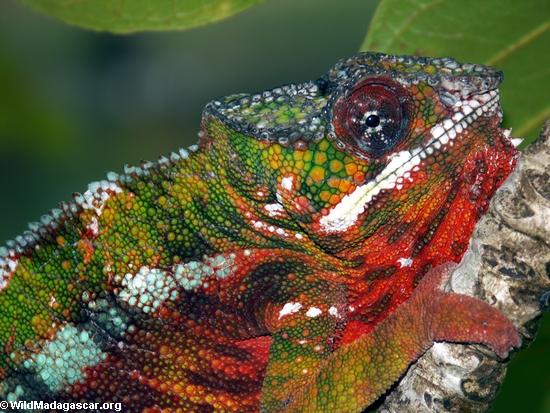 Panther chameleon in Maroantsetra, Madagascar. Photos by Rhett A. Butler. The panther chameleon, a lizard prized in the pet trade for its remarkable color changing abilities, may actually represent 11 different species, report researchers writing in the journal Molecular Ecology. Analyzing the genetics of more than 300 individual panther chameleons, Swiss and Malagasy researchers make […]
Panther chameleon in Maroantsetra, Madagascar. Photos by Rhett A. Butler. The panther chameleon, a lizard prized in the pet trade for its remarkable color changing abilities, may actually represent 11 different species, report researchers writing in the journal Molecular Ecology. Analyzing the genetics of more than 300 individual panther chameleons, Swiss and Malagasy researchers make […]
New species of monitor lizards found on the black market
 Monitor lizards, like this water monitor in Malaysia, are popular both in the pet trade and for consumption. Photo by Rhett A. Butler Searching the globe for undiscovered species takes biologists to far and remote locations, trekking through exotic locales that may yield a new discovery. However, exploring the black market can also produce results. […]
Monitor lizards, like this water monitor in Malaysia, are popular both in the pet trade and for consumption. Photo by Rhett A. Butler Searching the globe for undiscovered species takes biologists to far and remote locations, trekking through exotic locales that may yield a new discovery. However, exploring the black market can also produce results. […]
Lizard see, lizard do: scientists discover surprising behavior in reptiles
 Imitation can be obnoxious. For those with siblings, imitating your brother’s or sister’s every word was a surefire way to steadily drive them toward insanity. Annoying it may be, imitation is also special; it’s a behavior long regarded to be uniquely human. The skill of imitation is a little less exclusive now, as reptiles join […]
Imitation can be obnoxious. For those with siblings, imitating your brother’s or sister’s every word was a surefire way to steadily drive them toward insanity. Annoying it may be, imitation is also special; it’s a behavior long regarded to be uniquely human. The skill of imitation is a little less exclusive now, as reptiles join […]
Striking new gecko discovered in Thailand
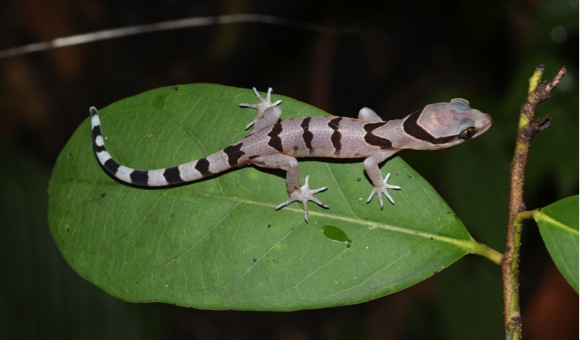 Sai Yok bent-toed gecko found on forested hill near Myanmar border, researchers think more species await discovery in biodiverse region A research team based in western Thailand has discovered a new gecko species in the Kanchanaburi Province, a region renowned for its number of species found nowhere else in the world. A recent publication in […]
Sai Yok bent-toed gecko found on forested hill near Myanmar border, researchers think more species await discovery in biodiverse region A research team based in western Thailand has discovered a new gecko species in the Kanchanaburi Province, a region renowned for its number of species found nowhere else in the world. A recent publication in […]
Meet the world’s rarest chameleon: Chapman’s pygmy
 Scientists propose expedition to find world’s rarest chameleon: Chapman’s pygmy chameleon A female Chapman’s pygmy chameleon (Rhampholeon chapmanorum
Scientists propose expedition to find world’s rarest chameleon: Chapman’s pygmy chameleon A female Chapman’s pygmy chameleon (Rhampholeon chapmanorum
Chameleon crisis: extinction threatens 36% of world’s chameleons
 World’s chameleons facing potential extinction crisis The lesser chameleon (Furcifer minor) is listed as Endangered. This species is only found in Madagascar. Photo by: Christopher V. Anderson. Chameleons are an unmistakable family of wonderfully bizarre reptiles. They sport long, shooting tongues; oddly-shaped horns or crests; and a prehensile tail like a monkey’s. But, of course, […]
World’s chameleons facing potential extinction crisis The lesser chameleon (Furcifer minor) is listed as Endangered. This species is only found in Madagascar. Photo by: Christopher V. Anderson. Chameleons are an unmistakable family of wonderfully bizarre reptiles. They sport long, shooting tongues; oddly-shaped horns or crests; and a prehensile tail like a monkey’s. But, of course, […]
Of bluefin and pufferfish: 310 species added to IUCN Red List
 Overfishing has pushed the Pacific bluefin tuna from Least Concern to Vulnerable on the IUCN Red List. Photo by: © Monterey Bay Aquarium – Randy Wilder. Today, 22,413 species are threatened with extinction, according to the most recent update of the IUCN Red List. This is a rise of 310 species from the last update […]
Overfishing has pushed the Pacific bluefin tuna from Least Concern to Vulnerable on the IUCN Red List. Photo by: © Monterey Bay Aquarium – Randy Wilder. Today, 22,413 species are threatened with extinction, according to the most recent update of the IUCN Red List. This is a rise of 310 species from the last update […]
New gecko described in Madagascar
 Juvenile and subadult of the new species Paroedura hordiesi. Credit: Jörn Köhler. Researchers have described a previously undocumented species of gecko in Madagascar. The species, named Paroedura hordiesi, lives among karst limestone massifs in the northern part of the Indian Ocean island nation. The lizard is notable for its skin pattern, which helps it blend […]
Juvenile and subadult of the new species Paroedura hordiesi. Credit: Jörn Köhler. Researchers have described a previously undocumented species of gecko in Madagascar. The species, named Paroedura hordiesi, lives among karst limestone massifs in the northern part of the Indian Ocean island nation. The lizard is notable for its skin pattern, which helps it blend […]
Hitchhiking Caribbean lizard upends island biogeography theory
 An anole lizard silhouetted on a rainforest leaf. Photo by Rhett A. Butler. The biggest factor determining species diversity and distribution on islands is not size and isolation, as traditional island biogeography theory states, but economics. Simply put, the more trade an island is engaged in, the more boats visit it, and with more boats […]
An anole lizard silhouetted on a rainforest leaf. Photo by Rhett A. Butler. The biggest factor determining species diversity and distribution on islands is not size and isolation, as traditional island biogeography theory states, but economics. Simply put, the more trade an island is engaged in, the more boats visit it, and with more boats […]
Scientists uncover six potentially new species in Peru, including bizarre aquatic mammal (photos)
 This potentially new lizard species was discovered on the last day of a survey in a cloud forest in Andean Peru. Photo: Luis Mamani. A group of Peruvian and Mexican scientists say they have uncovered at least six new species near South America’s most famous archaeological site: Machu Picchu. The discoveries include a new mammal, […]
This potentially new lizard species was discovered on the last day of a survey in a cloud forest in Andean Peru. Photo: Luis Mamani. A group of Peruvian and Mexican scientists say they have uncovered at least six new species near South America’s most famous archaeological site: Machu Picchu. The discoveries include a new mammal, […]
Bizarre lizard newest victim of reptile pet trade
 The earless monitor lizard (Lanthanotus borneensis). Barely seen since its description in 1878, the species has suddenly become a victim of wildlife trafficking for the pet trade. Photo by: Indraneil Das. If you’ve never heard of the earless monitor lizard, you’re not alone: this little-known, cryptic lizard has long-escaped the attention of the larger public. […]
The earless monitor lizard (Lanthanotus borneensis). Barely seen since its description in 1878, the species has suddenly become a victim of wildlife trafficking for the pet trade. Photo by: Indraneil Das. If you’ve never heard of the earless monitor lizard, you’re not alone: this little-known, cryptic lizard has long-escaped the attention of the larger public. […]
Google Earth spurs discovery of a ‘new’ chameleon species
 At around 7-8 cm long, the Mount Mabu pygmy chameleon (Rhampholeon maspictus) is a relatively large species. Its name comes from the Latin for ‘painted man’, reflecting the striking green, blue and yellow coloration of breeding males. Image credit: William R. Branch, caption courtesy of Fauna & Flora International Google Earth has spurred the discovery […]
At around 7-8 cm long, the Mount Mabu pygmy chameleon (Rhampholeon maspictus) is a relatively large species. Its name comes from the Latin for ‘painted man’, reflecting the striking green, blue and yellow coloration of breeding males. Image credit: William R. Branch, caption courtesy of Fauna & Flora International Google Earth has spurred the discovery […]
Emerald-faced reptile discovered in Ecuador
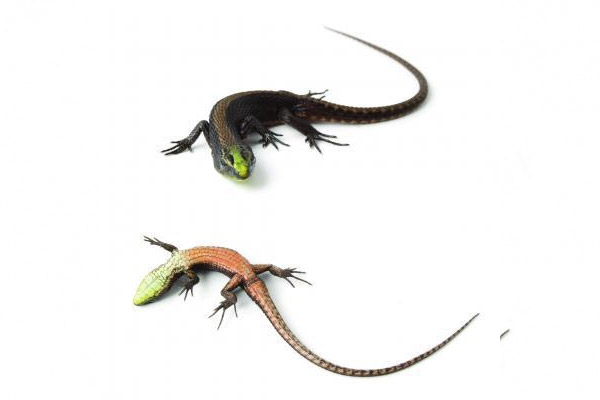 A two inch long Alopoglossus viridiceps shade lizard. Photo by Torres-Carvajal Researchers have discovered a colorful lizard species in the cloud forests of northwestern Ecuador. The species, dubbed Alopoglossus viridiceps, is a type of shade lizard. It is described in a recent issue of the journal ZooKeys. Like other shade lizards, Alopoglossus viridiceps lives in […]
A two inch long Alopoglossus viridiceps shade lizard. Photo by Torres-Carvajal Researchers have discovered a colorful lizard species in the cloud forests of northwestern Ecuador. The species, dubbed Alopoglossus viridiceps, is a type of shade lizard. It is described in a recent issue of the journal ZooKeys. Like other shade lizards, Alopoglossus viridiceps lives in […]
Olinguito, tinkerbell, and a dragon: meet the top 10 new species of 2013
 The Cape Melville leaf-tailed gecko (Saltuarius eximius) is one of the top ten new species from 2013. Photo by: Conrad Hoskin. Out of around 18,000 new species described and named last year, scientists have highlighted ten in an effort to raise awareness about the imperiled biodiversity around us. Each species—from a teddy-bear-like carnivore in the […]
The Cape Melville leaf-tailed gecko (Saltuarius eximius) is one of the top ten new species from 2013. Photo by: Conrad Hoskin. Out of around 18,000 new species described and named last year, scientists have highlighted ten in an effort to raise awareness about the imperiled biodiversity around us. Each species—from a teddy-bear-like carnivore in the […]
Will they hold on? Three new gecko species found in threatened habitat
 Malaysia is set to lose ancient limestone formations to quarrying despite the discovery of new species of geckos in the area. The species are described by Dr. L. Lee Grismer from California’s La Sierra University in three studies recently published in the journal Zootaxa. One of Grismer’s discoveries, Cyrtodactylus metropolis, is the first endemic vertebrate […]
Malaysia is set to lose ancient limestone formations to quarrying despite the discovery of new species of geckos in the area. The species are described by Dr. L. Lee Grismer from California’s La Sierra University in three studies recently published in the journal Zootaxa. One of Grismer’s discoveries, Cyrtodactylus metropolis, is the first endemic vertebrate […]
Photos: Weird aquatic lizard discovered in mountain streams of Peru
 Male Potamites erythrocularis stream lizard. Photo by Alessandro Catenazzi. A ‘new’ species of lizard has been described from the cloud forests of Peru’s Manu National Park, reports SERNANP, the Peruvian National Park Service. Potamites erythrocularis, an aquatic lizard that lives in cold streams at an elevation of of 900-2000 meters, was discovered during herpetological studies […]
Male Potamites erythrocularis stream lizard. Photo by Alessandro Catenazzi. A ‘new’ species of lizard has been described from the cloud forests of Peru’s Manu National Park, reports SERNANP, the Peruvian National Park Service. Potamites erythrocularis, an aquatic lizard that lives in cold streams at an elevation of of 900-2000 meters, was discovered during herpetological studies […]
Scientists discover new gecko hanging-on in single forest fragment
 Scientists have identified a new species of day gecko that is the largest in its genus (Cnemaspis) to be found in Sri Lanka. To date, it has been observed only within the Rammalakanda Reserve in southern Sri Lanka, an area spanning just 1,700 hectares, raising questions about the viability of this population and hence the […]
Scientists have identified a new species of day gecko that is the largest in its genus (Cnemaspis) to be found in Sri Lanka. To date, it has been observed only within the Rammalakanda Reserve in southern Sri Lanka, an area spanning just 1,700 hectares, raising questions about the viability of this population and hence the […]
Next big idea in forest conservation? Incentivizing keeping primary forests intact
 Innovation in Tropical Forest Conservation: Q&A with Corey Bradshaw Primary peat forest in Sumatra. Photo by Rhett A. Butler. Much of Dr. Corey Bradshaw’s work has a singular aim: to keep primary habitats and functioning ecosystems intact. According to Bradshaw, the existing system of carbon trading rules needs to be changed so that primary forests […]
Innovation in Tropical Forest Conservation: Q&A with Corey Bradshaw Primary peat forest in Sumatra. Photo by Rhett A. Butler. Much of Dr. Corey Bradshaw’s work has a singular aim: to keep primary habitats and functioning ecosystems intact. According to Bradshaw, the existing system of carbon trading rules needs to be changed so that primary forests […]
One lizard, four species: the collared treerunner
 Collared treerunner in Colombia. Photo by Rhett A. Butler Now, that’s a horse of a different color. Or, in this case, a lizard of another species—four species. Recent research suggests that the collared treerunner (Plica plica), previously thought of as one widespread species, is actually four distinct species inhabiting diverse geographical areas east of the […]
Collared treerunner in Colombia. Photo by Rhett A. Butler Now, that’s a horse of a different color. Or, in this case, a lizard of another species—four species. Recent research suggests that the collared treerunner (Plica plica), previously thought of as one widespread species, is actually four distinct species inhabiting diverse geographical areas east of the […]
Microhabitats could buffer some rainforest animals against climate change
 As temperatures increase worldwide due to anthropogenic climate change, scientists are scrambling to figure out if species will be able to survive rapidly warming ecosystems. A new study in Global Change Biology offers a little hope. Studying reptiles and amphibians in the Philippines, scientists say some of these species may be able to seek refuge […]
As temperatures increase worldwide due to anthropogenic climate change, scientists are scrambling to figure out if species will be able to survive rapidly warming ecosystems. A new study in Global Change Biology offers a little hope. Studying reptiles and amphibians in the Philippines, scientists say some of these species may be able to seek refuge […]
Scientists identify individual lizards by their irises
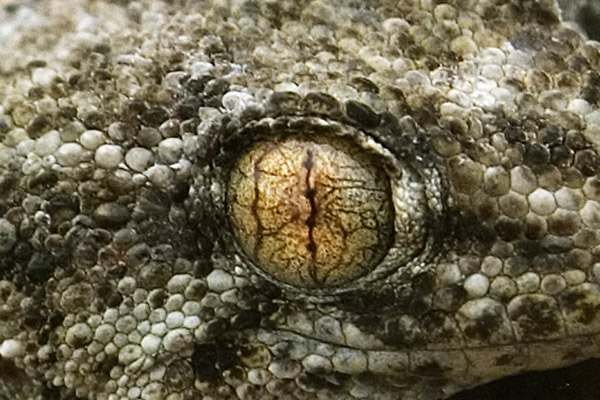 Institutions and governments have been scanning human irises for years to verify one’s identity—Google has been using this method since 2011—but could iris-scanning be employed on other species as well? According to a new study in Amphibia-Reptila, the answer is “yes.” Scientists have recently employed iris scanning to visually distinguish individuals of an imperiled gecko […]
Institutions and governments have been scanning human irises for years to verify one’s identity—Google has been using this method since 2011—but could iris-scanning be employed on other species as well? According to a new study in Amphibia-Reptila, the answer is “yes.” Scientists have recently employed iris scanning to visually distinguish individuals of an imperiled gecko […]
New to science: 2 lizards, 1 frog discovered on Australian expedition (pictures)
 New leaf-tail gecko. Photo copyright Tim Laman / National Geographic Researchers from James Cook University and National Geographic discovered three new herp species — a cryptic leaf-tail gecko, a colorful skink, and a frog — during an expedition to northeastern Australia. The species are described in three papers published in October in the journal Zootaxa. […]
New leaf-tail gecko. Photo copyright Tim Laman / National Geographic Researchers from James Cook University and National Geographic discovered three new herp species — a cryptic leaf-tail gecko, a colorful skink, and a frog — during an expedition to northeastern Australia. The species are described in three papers published in October in the journal Zootaxa. […]
4 new species of legless lizards discovered in California
 Four previously unknown species of legless lizard have been described in California, report researchers from the University of California at Berkeley and Cal State-Fullerton. The species, all members of the Anniella genus, were hiding in plain site, living in marginal habitats that included “a vacant lot in downtown Bakersfield, among oil derricks in the lower […]
Four previously unknown species of legless lizard have been described in California, report researchers from the University of California at Berkeley and Cal State-Fullerton. The species, all members of the Anniella genus, were hiding in plain site, living in marginal habitats that included “a vacant lot in downtown Bakersfield, among oil derricks in the lower […]
The iguana man: saving the reptilian kings of the Bahamas
 Before the arrival of humans—with their dogs, cats, and wild pigs—the northern Bahamian rock iguana ruled its home range, being pound-for-pound among the biggest land animals on the islands. In these ecosystems, the iguana’s were the mega-grazers, the bison and elk of the Caribbean one might say. But hunting by humans, invasive species, and habitat […]
Before the arrival of humans—with their dogs, cats, and wild pigs—the northern Bahamian rock iguana ruled its home range, being pound-for-pound among the biggest land animals on the islands. In these ecosystems, the iguana’s were the mega-grazers, the bison and elk of the Caribbean one might say. But hunting by humans, invasive species, and habitat […]
Dominican Republic sends bulldozers to destroy wildlife reserve, home to endangered species
 Last Wednesday, bulldozers entered the Loma Charco Azul Biological Reserve (LCABR) in the Dominican Republic and began clearing vegetation for agricultural development. The move stunned local conservationists who had not been notified ahead of time of the project. Although Charco Azul Biological Reserve is home to a wealth of threatened species—including the world’s largest population […]
Last Wednesday, bulldozers entered the Loma Charco Azul Biological Reserve (LCABR) in the Dominican Republic and began clearing vegetation for agricultural development. The move stunned local conservationists who had not been notified ahead of time of the project. Although Charco Azul Biological Reserve is home to a wealth of threatened species—including the world’s largest population […]
Monitor lizards vanishing to international trade in pets and skins
 Illegally traded lizards (left to right): black tree monitor (Varanus beccarii), Reisinger’s tree monitor (Varanus reisingeri), emerald monitor (Varanus prasinus), and the blue-spotted tree monitor (Varanus macraei). Photo courtesy of Jessica Lyons. The world’s monitor lizards remind us that the world was once ruled by reptiles: this genus (Varanus) includes the world’s biggest lizards, such […]
Illegally traded lizards (left to right): black tree monitor (Varanus beccarii), Reisinger’s tree monitor (Varanus reisingeri), emerald monitor (Varanus prasinus), and the blue-spotted tree monitor (Varanus macraei). Photo courtesy of Jessica Lyons. The world’s monitor lizards remind us that the world was once ruled by reptiles: this genus (Varanus) includes the world’s biggest lizards, such […]
Market figures out that geckos don’t cure AIDS, but killing continues
 Millions of tokay geckos continue to be traded for traditional medicine, despite waning belief that the colorful lizards are a cure for AIDS, reports a new study from TRAFFIC. The study found that a spike in tokay gecko demand due to rumors that it could cure HIV/AIDS was relatively short-lived, lasting from 2009 and early […]
Millions of tokay geckos continue to be traded for traditional medicine, despite waning belief that the colorful lizards are a cure for AIDS, reports a new study from TRAFFIC. The study found that a spike in tokay gecko demand due to rumors that it could cure HIV/AIDS was relatively short-lived, lasting from 2009 and early […]
Madagascar’s chameleons came from African mainland
 Parson’s chameleon in Madagascar Madagascar’s color-changing chameleons originated in Africa and crossed over to the island some 65 million years ago, concludes a study published this week in the Proceedings of the Royal Society B. The research, which is based on genetic analysis of 174 chameleon species, found that the ancestors of today’s chameleons crossed […]
Parson’s chameleon in Madagascar Madagascar’s color-changing chameleons originated in Africa and crossed over to the island some 65 million years ago, concludes a study published this week in the Proceedings of the Royal Society B. The research, which is based on genetic analysis of 174 chameleon species, found that the ancestors of today’s chameleons crossed […]
Scientists discover two new remarkably-colored lizards in the Peruvian Amazon (photos)
 New species of woodlizard: Enyalioides binzayedi. Photo by: P.J. Venegas. Scientists have discovered two new species of woodlizards from the Peruvian Amazon. Woodlizards, in the genus Enyalioides, are little-known reptiles with only 10 described species found in South and Central America. Described in a new paper in ZooKeys, both new woodlizards were found in Cordillera […]
New species of woodlizard: Enyalioides binzayedi. Photo by: P.J. Venegas. Scientists have discovered two new species of woodlizards from the Peruvian Amazon. Woodlizards, in the genus Enyalioides, are little-known reptiles with only 10 described species found in South and Central America. Described in a new paper in ZooKeys, both new woodlizards were found in Cordillera […]
Pictures: 20% of the world’s reptiles endangered
 Green iguana in Colombia. Photo by Rhett A. Butler Nearly a fifth the planet’s reptiles are threatened with extinction, warns a new assessment published in the journal Biological Conservation. The analysis, carried out by experts with the Zoological Society of London (ZSL) and the IUCN Species Survival Commission (SSC), is based on the extinction risk […]
Green iguana in Colombia. Photo by Rhett A. Butler Nearly a fifth the planet’s reptiles are threatened with extinction, warns a new assessment published in the journal Biological Conservation. The analysis, carried out by experts with the Zoological Society of London (ZSL) and the IUCN Species Survival Commission (SSC), is based on the extinction risk […]
New population of nearly extinct Madagascar chameleon discovered
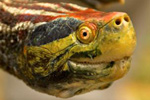 Scientists have discovered a new population of the Belalanda chameleon (Furcifer belalandaensis), boosting hope for one of Madagascar’s rarest chameleons. While the species was known only from a handful of trees in two Malagasy villages, researchers from the University of Kent’s Durrell Institute of Conservation and Ecology (DICE) have discovered another population near a third […]
Scientists have discovered a new population of the Belalanda chameleon (Furcifer belalandaensis), boosting hope for one of Madagascar’s rarest chameleons. While the species was known only from a handful of trees in two Malagasy villages, researchers from the University of Kent’s Durrell Institute of Conservation and Ecology (DICE) have discovered another population near a third […]
Photo: Subterranean ‘Moby Dick’ mermaid lizard discovered in Madagascar
 Sirenoscincus mobydick. Image courtesy of France’s National Centre for Scientific Research. An international team of scientists have described a bizarre new species of worm-like lizard that lives underground. Strangely, they named it the “Moby Dick” mermaid skink. The researchers chose Sirenoscincus mobydick for the lizard’s unusual appearance, which includes a complete absence of pigmentation, a […]
Sirenoscincus mobydick. Image courtesy of France’s National Centre for Scientific Research. An international team of scientists have described a bizarre new species of worm-like lizard that lives underground. Strangely, they named it the “Moby Dick” mermaid skink. The researchers chose Sirenoscincus mobydick for the lizard’s unusual appearance, which includes a complete absence of pigmentation, a […]
Photos: Neon blue dragon discovered in Vietnamese rainforest
 Male Calotes bachae. Photo by Peter Geissler. German and Russian biologists have discovered a stunning new species of lizard in Vietnam. The species, dubbed Calotes bachae, is described in a recent issue of the journal Zootaxa. Calotes bachae is a type of agama, a group of lizards commonly known as “forest dragons.” It was described […]
Male Calotes bachae. Photo by Peter Geissler. German and Russian biologists have discovered a stunning new species of lizard in Vietnam. The species, dubbed Calotes bachae, is described in a recent issue of the journal Zootaxa. Calotes bachae is a type of agama, a group of lizards commonly known as “forest dragons.” It was described […]
Picture gallery of the day: Day geckos
 The critically endangered electric blue day gecko (Lygodactylus willoamsi) from Tanzania. This species is being bred in captivity — wild populations are suffering from habitat destruction and over-collection for the pet trade. Day geckos are the jewels of the gecko family. Unlike most geckos which are nocturnal and often cryptic in coloration, day geckos are […]
The critically endangered electric blue day gecko (Lygodactylus willoamsi) from Tanzania. This species is being bred in captivity — wild populations are suffering from habitat destruction and over-collection for the pet trade. Day geckos are the jewels of the gecko family. Unlike most geckos which are nocturnal and often cryptic in coloration, day geckos are […]
Animals of the Masai Mara – book review
 Spotted hyena in the Masai Mara. Photo by: Rhett A. Butler. Animals of the Masai Mara is the first illustrated guidebook to the Masai Mara region along the Kenya and Tanzania border. This is the world famous region of wildebeest migrations, large felines, towering African elephants, fascinating cultures, and great flora and fauna diversity. This […]
Spotted hyena in the Masai Mara. Photo by: Rhett A. Butler. Animals of the Masai Mara is the first illustrated guidebook to the Masai Mara region along the Kenya and Tanzania border. This is the world famous region of wildebeest migrations, large felines, towering African elephants, fascinating cultures, and great flora and fauna diversity. This […]
Photos: 3 colorful lizard species discovered in Australia
 Researchers in Australia have described three new lizard species from the northwestern part of the continent. The new species — the Elegant Rainbow Skink (Carlia decora), the Orange-flanked Rainbow Skink (Carlia rubigo), and the Whitsunday Rainbow Skink (Carlia inconnexa) — are described in the journal Zootaxa. The species were identified after careful study of the […]
Researchers in Australia have described three new lizard species from the northwestern part of the continent. The new species — the Elegant Rainbow Skink (Carlia decora), the Orange-flanked Rainbow Skink (Carlia rubigo), and the Whitsunday Rainbow Skink (Carlia inconnexa) — are described in the journal Zootaxa. The species were identified after careful study of the […]
Indonesia remains epicenter for illegal wildlife trade in reptiles and amphibians
 Illegally traded lizards (left to right): black tree monitor (Varanus beccarii), Reisinger’s tree monitor (Varanus reisingeri), emerald monitor (Varanus prasinus), and the blue-spotted tree monitor (Varanus macraei). Photo courtesy of Jessica Lyons. Demand for exotic pets is driving the illegal harvest and trade of herpetofauna (reptiles and amphibians) in Indonesian New Guinea, according to a […]
Illegally traded lizards (left to right): black tree monitor (Varanus beccarii), Reisinger’s tree monitor (Varanus reisingeri), emerald monitor (Varanus prasinus), and the blue-spotted tree monitor (Varanus macraei). Photo courtesy of Jessica Lyons. Demand for exotic pets is driving the illegal harvest and trade of herpetofauna (reptiles and amphibians) in Indonesian New Guinea, according to a […]
Remarkable comeback: blue iguana downgraded to Endangered after determined conservation efforts
 Blue iguana in Queen Elizabeth II Botanic Park. Photo by: Lhb1239. The wild blue iguana population has increased by at least 15 times in the last ten years, prompting the IUCN Red List to move the species from Critically Endangered to just Endangered. A targeted, ambitious conservation program, headed by the Blue Iguana Recovery Team, […]
Blue iguana in Queen Elizabeth II Botanic Park. Photo by: Lhb1239. The wild blue iguana population has increased by at least 15 times in the last ten years, prompting the IUCN Red List to move the species from Critically Endangered to just Endangered. A targeted, ambitious conservation program, headed by the Blue Iguana Recovery Team, […]
Animal pictures of the day: booming captive breeding for Mauritius skinks
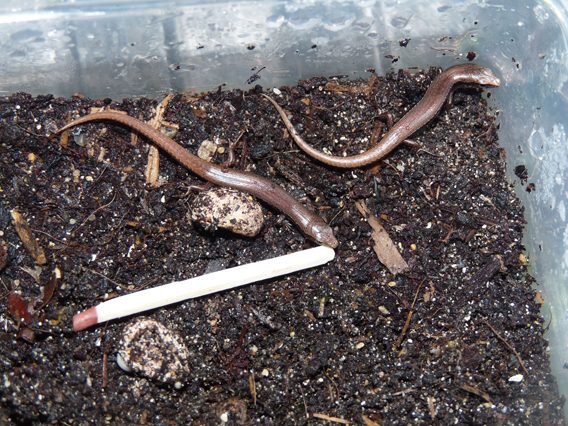 Orange-tailed skink hatchlings meet their match in a matchstick. Photo courtesy of the Durrell Wildlife Conservation Trust (DWCT). Three female orange-tailed skinks skinks have produced 16 skink babies in just four months, according to the Durrell Wildlife Conservation Trust (DWCT), which is captive breeding the Critically Endangered species. The breeding efforts are all the more […]
Orange-tailed skink hatchlings meet their match in a matchstick. Photo courtesy of the Durrell Wildlife Conservation Trust (DWCT). Three female orange-tailed skinks skinks have produced 16 skink babies in just four months, according to the Durrell Wildlife Conservation Trust (DWCT), which is captive breeding the Critically Endangered species. The breeding efforts are all the more […]
Cute animal picture of the day: baby Yemen chameleons
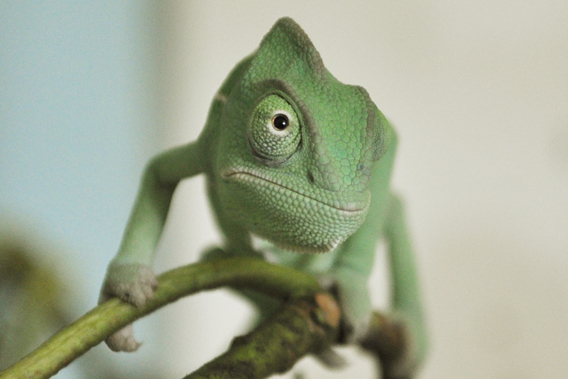 Baby Yemen chameleon. Photo courtesy of ZSL Whipsnade Zoo. Ten Yemen chameleons (Chamaeleo calyptratus) were recently born at the Zoological Society of London’s (ZSL) Whipsnade Zoo. A popular pet species, the chameleons, also known as veiled chameleons, still thrive in the mountainous wilds of Yemen and Saudi Arabia. It is listed as Least Concern by […]
Baby Yemen chameleon. Photo courtesy of ZSL Whipsnade Zoo. Ten Yemen chameleons (Chamaeleo calyptratus) were recently born at the Zoological Society of London’s (ZSL) Whipsnade Zoo. A popular pet species, the chameleons, also known as veiled chameleons, still thrive in the mountainous wilds of Yemen and Saudi Arabia. It is listed as Least Concern by […]
Picture: Blue-tongued monitor lizard
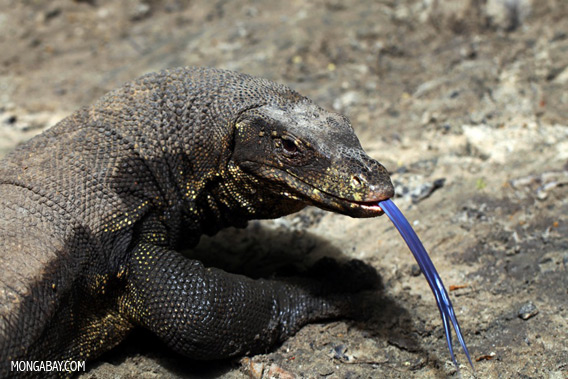 Water monitor photographed in Sabah, on the island of Borneo. The monitor lizards is known as ‘biawak’ in Malay. Picture by Rhett A. Butler. The Southeast Asian water monitor (Varanus salvator macromaculatus) is distributed widely across Southeast Asia. Reaching a length of up to 3 meters (10 feet), the species is one of the largest […]
Water monitor photographed in Sabah, on the island of Borneo. The monitor lizards is known as ‘biawak’ in Malay. Picture by Rhett A. Butler. The Southeast Asian water monitor (Varanus salvator macromaculatus) is distributed widely across Southeast Asia. Reaching a length of up to 3 meters (10 feet), the species is one of the largest […]
New armored lizard discovered in landmine-riddled region
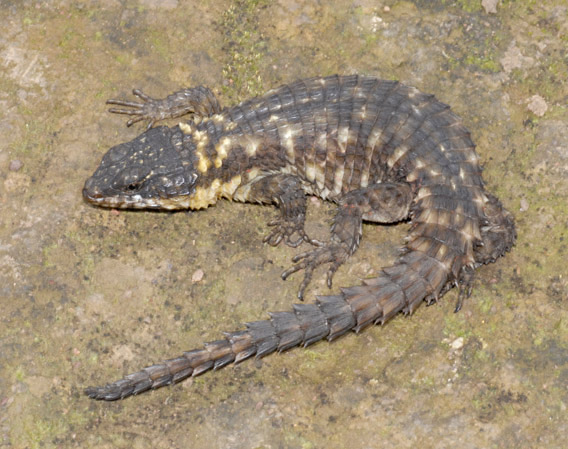 The new species of lizard, Cordylus marunguensi, from the Democratic Republic of Congo. Photo courtesy of Eli Greenbaum. A new lizard has been discovered in a war-torn area of the Democratic Republic of the Congo (DRC). According to a paper in the African Journal of Herpetology, the new species was found hiding under a rock […]
The new species of lizard, Cordylus marunguensi, from the Democratic Republic of Congo. Photo courtesy of Eli Greenbaum. A new lizard has been discovered in a war-torn area of the Democratic Republic of the Congo (DRC). According to a paper in the African Journal of Herpetology, the new species was found hiding under a rock […]
Skink biodiversity jumps 650 percent in the Caribbean
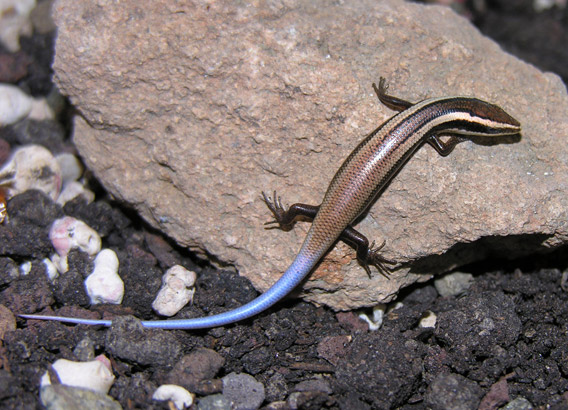 New species: the Anguilla Bank skink. Photo by: Karl Questal. In a single paper in Zootaxa scientists have rewritten the current understanding of lizard biodiversity in the Caribbean. By going over museum specimens of skinks, scientists have discovered 24 new species and re-established nine species previously described species, long-thought invalid. The single paper has increased […]
New species: the Anguilla Bank skink. Photo by: Karl Questal. In a single paper in Zootaxa scientists have rewritten the current understanding of lizard biodiversity in the Caribbean. By going over museum specimens of skinks, scientists have discovered 24 new species and re-established nine species previously described species, long-thought invalid. The single paper has increased […]
New reptile discovered in world’s strangest archipelago
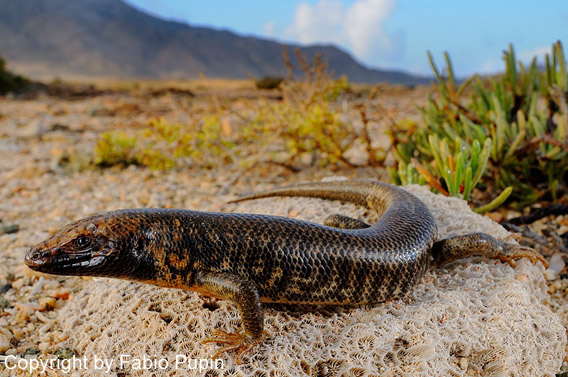 Trachylepis cristinae, a newly described skink that is only found on Abd Al Kuri Island. Photo by: Fabio Pupin. Few people have ever heard of the Socotra Archipelago even though, biologically-speaking, it is among the world’s most wondrous set of islands. Over one third of Socotra’s plants are found no-where else on Earth, i.e. endemic, […]
Trachylepis cristinae, a newly described skink that is only found on Abd Al Kuri Island. Photo by: Fabio Pupin. Few people have ever heard of the Socotra Archipelago even though, biologically-speaking, it is among the world’s most wondrous set of islands. Over one third of Socotra’s plants are found no-where else on Earth, i.e. endemic, […]
Photo: New ‘bumblebee’ gecko discovered in New Guinea
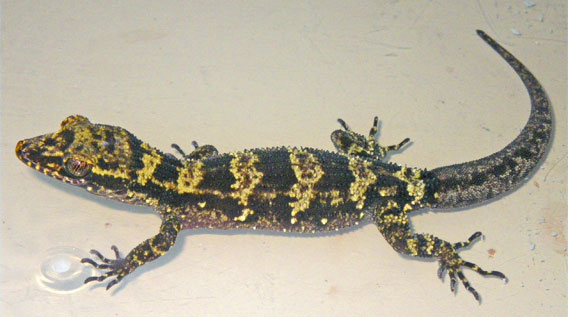 The Bumblebee Gecko (Nactus kunan) from Manus Island off Papua New Guinea was discovered in 2010, and described as a new species in 2012. Photo by Robert Fisher of the U.S. Geological Survey Researchers from the Papua New Guinea National Museum and the U.S. Geological Survey have discovered a new species of gecko on an […]
The Bumblebee Gecko (Nactus kunan) from Manus Island off Papua New Guinea was discovered in 2010, and described as a new species in 2012. Photo by Robert Fisher of the U.S. Geological Survey Researchers from the Papua New Guinea National Museum and the U.S. Geological Survey have discovered a new species of gecko on an […]
Photo: World’s smallest chameleon discovered in Madagascar
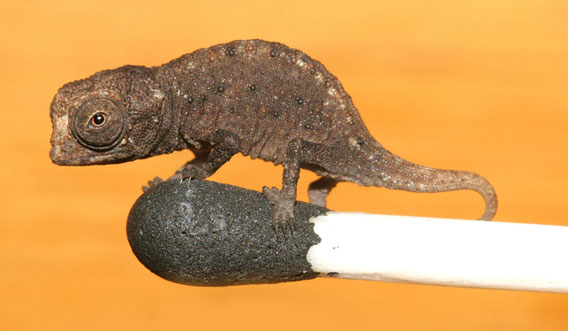 Juvenile Brookesia micra on match. Scientists have discovered four new species of super-tiny chameleons in Madagascar, according to a new paper in PLoS ONE. The smallest of the new species, Brookesia micra, is found only on the small island of Nosy Hara and has been dubbed the smallest chameleon in the world, measuring from nose […]
Juvenile Brookesia micra on match. Scientists have discovered four new species of super-tiny chameleons in Madagascar, according to a new paper in PLoS ONE. The smallest of the new species, Brookesia micra, is found only on the small island of Nosy Hara and has been dubbed the smallest chameleon in the world, measuring from nose […]
Photo: new blue, red, yellow lizard discovered in the Andes
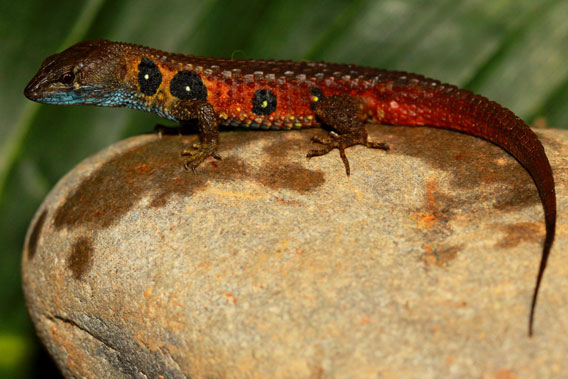 A male Potamites montanicola, a new species of lizard discovered in the Peruvian Andes. Photo courtesy of German Chávez. Researchers have discovered a new species of lizard in the Peruvian Andes, whose males sport beautiful colors, according to a paper in ZooKeys. The highest-dwelling known species of the genus Potamites, the new lizard, dubbed Potamites […]
A male Potamites montanicola, a new species of lizard discovered in the Peruvian Andes. Photo courtesy of German Chávez. Researchers have discovered a new species of lizard in the Peruvian Andes, whose males sport beautiful colors, according to a paper in ZooKeys. The highest-dwelling known species of the genus Potamites, the new lizard, dubbed Potamites […]
Climate change may make lizards smarter, if they don’t go extinct first
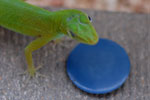 A new study in Biology Letters has found that warmer temperatures may make lizards smarter, even as past studies have linked a global decline in lizards to climate change. Looking at Australia’s Eastern three-lined skink (Bassiana duperreyi), researchers found that warm temperatures during incubation not only resulted in larger individuals (a result confirmed in previous […]
A new study in Biology Letters has found that warmer temperatures may make lizards smarter, even as past studies have linked a global decline in lizards to climate change. Looking at Australia’s Eastern three-lined skink (Bassiana duperreyi), researchers found that warm temperatures during incubation not only resulted in larger individuals (a result confirmed in previous […]
Animal picture of the day: dueling green iguanas
 Bloodied male green iguanas fight in Colombia. All photos by: Rhett A. Butler. Found throughout Central and South America and parts of the Caribbean, the green iguana (Iguana iguana) is a large, mostly herbivorous lizard. The species, which has not been evaluated by the IUCN Red List, is threatened by the pet trade, habitat loss, […]
Bloodied male green iguanas fight in Colombia. All photos by: Rhett A. Butler. Found throughout Central and South America and parts of the Caribbean, the green iguana (Iguana iguana) is a large, mostly herbivorous lizard. The species, which has not been evaluated by the IUCN Red List, is threatened by the pet trade, habitat loss, […]
The dark side of new species discovery
 This interview is an excerpt from The WildLife with Laurel Neme, a program that explores the mysteries of the animal world through interviews with scientists and other wildlife investigators. “The WildLife” airs every Monday from 1-2 pm EST on WOMM-LP, 105.9 FM in Burlington, Vermont. You can livestream it at theradiator.org or download the podcast […]
This interview is an excerpt from The WildLife with Laurel Neme, a program that explores the mysteries of the animal world through interviews with scientists and other wildlife investigators. “The WildLife” airs every Monday from 1-2 pm EST on WOMM-LP, 105.9 FM in Burlington, Vermont. You can livestream it at theradiator.org or download the podcast […]
Photos: 40% of Madagascar’s reptiles at risk of extinction
 The critically endangered radiated tortoise. All photos by Rhett Butler 40 percent of Madagascar’s terrestrial reptiles are threatened with extinction due to habitat loss and over-collection for the pet trade, reports the International Union for Conservation of Nature (IUCN) in its latest update of the Red List of Threatened Species. Experts from around the world […]
The critically endangered radiated tortoise. All photos by Rhett Butler 40 percent of Madagascar’s terrestrial reptiles are threatened with extinction due to habitat loss and over-collection for the pet trade, reports the International Union for Conservation of Nature (IUCN) in its latest update of the Red List of Threatened Species. Experts from around the world […]
Animal picture of the day: the world’s most blue lizard?
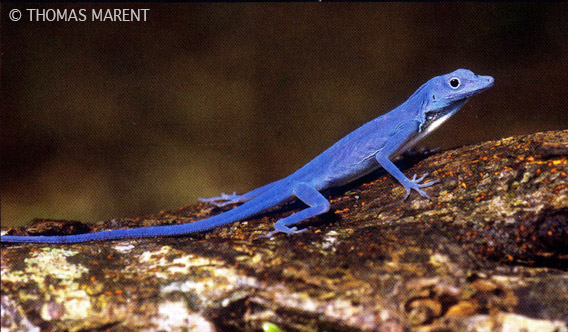 A blue anole on Gorgona Island, Colombia. Photo from Thomas Marent’s book, “Rainforest“. Used with permission. The blue anole is one of the world’s most spectacular reptiles. Found only on the island of Gorgona, the blue anole is so elusive and rare that scientists have been unable to give an estimate of its population. However […]
A blue anole on Gorgona Island, Colombia. Photo from Thomas Marent’s book, “Rainforest“. Used with permission. The blue anole is one of the world’s most spectacular reptiles. Found only on the island of Gorgona, the blue anole is so elusive and rare that scientists have been unable to give an estimate of its population. However […]
Brainy lizards rival birds in intelligence
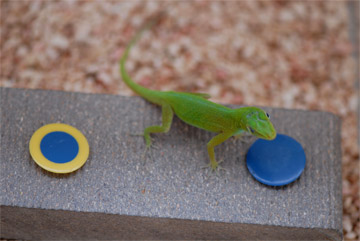 Reptiles have long been thought to be dim-witted, but a new study in Biology Letters finds that the Puerto Rican anole, a type of lizard, can match birds in smarts. Using cognitive tests that have been previously used on birds, researchers with Duke University found that the lizards were capable of solving a problem they’ve […]
Reptiles have long been thought to be dim-witted, but a new study in Biology Letters finds that the Puerto Rican anole, a type of lizard, can match birds in smarts. Using cognitive tests that have been previously used on birds, researchers with Duke University found that the lizards were capable of solving a problem they’ve […]
Endangered Madagascar wildlife on sale in Thailand
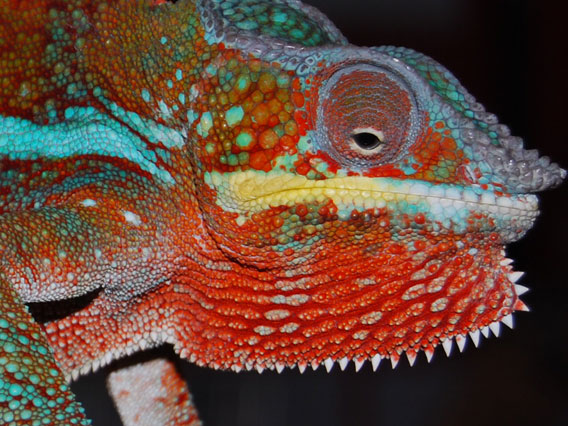 This male Panther Chameleon, originating from Nosy Mangabe, Madagascar, was observed at a dealer’s house in Saraburi city, Thailand, January 2010. © M Todd/TRAFFIC. Conservation group TRAFFIC uncovered nearly 600 Madagascar reptiles and amphibians on sale in Thai markets, including endangered species and those banned for sale by the Convention on International Trade in Endangered […]
This male Panther Chameleon, originating from Nosy Mangabe, Madagascar, was observed at a dealer’s house in Saraburi city, Thailand, January 2010. © M Todd/TRAFFIC. Conservation group TRAFFIC uncovered nearly 600 Madagascar reptiles and amphibians on sale in Thai markets, including endangered species and those banned for sale by the Convention on International Trade in Endangered […]
Traditional Chinese medicine trade takes toll on Indonesia’s geckos
 This commentary original appeared at the Jakarta Globe as Where Have All the Geckos Gone? and has been posted here with the permission of the authors. The call of the tokek, or gecko, is one of the most familiar sounds in Indonesia. Next to the smell of clove cigarettes, the calls to prayer, the friendly […]
This commentary original appeared at the Jakarta Globe as Where Have All the Geckos Gone? and has been posted here with the permission of the authors. The call of the tokek, or gecko, is one of the most familiar sounds in Indonesia. Next to the smell of clove cigarettes, the calls to prayer, the friendly […]
World’s ‘most social’ lizard builds multigenerational homes
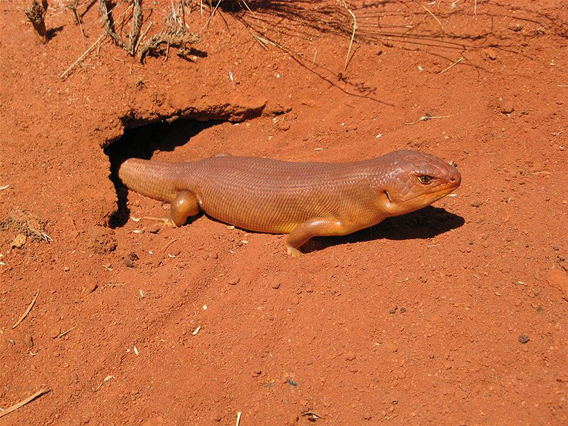 A great desert skinks popping out of its burrow. Photo by: Adam Stow, Macquarie University. Researchers from Macquarie University in Australia have discovered that the threatened great desert burrowing skink lizard forms stable families that construct and maintain elaborate underground homes, reports ABC News. This is the first lizard in the world known to practice […]
A great desert skinks popping out of its burrow. Photo by: Adam Stow, Macquarie University. Researchers from Macquarie University in Australia have discovered that the threatened great desert burrowing skink lizard forms stable families that construct and maintain elaborate underground homes, reports ABC News. This is the first lizard in the world known to practice […]
Photos: the top ten new species discovered in 2010
- If we had to characterize our understanding of life on Earth as either ignorant or knowledgeable, the former would be most correct.
- In 250 years of rigorous taxonomic work researchers have cataloged nearly two million species, however scientists estimate the total number of species on Earth is at least five million and perhaps up to a hundred million.
- This means every year thousands of new species are discovered by researchers, and from these thousands, the International Institute for Species Exploration at Arizona State University selects ten especially notable new species.
No limbs or sight needed: bizarre new lizard uncovered in Cambodia
 The newly discovered Dalai Mountain blind lizard (Dibamus dalaiensis). Photo courtesy of Fauna & Flora International. A new species of legless lizard has been discovered in Cambodia. Herpetologist Neang Thy uncovered, literally, the new species when he turned over a log in the species-rich Cardamom Mountains. While the new lizard looks like a snake or […]
The newly discovered Dalai Mountain blind lizard (Dibamus dalaiensis). Photo courtesy of Fauna & Flora International. A new species of legless lizard has been discovered in Cambodia. Herpetologist Neang Thy uncovered, literally, the new species when he turned over a log in the species-rich Cardamom Mountains. While the new lizard looks like a snake or […]
Over a thousand geckos freed from criminal taxi
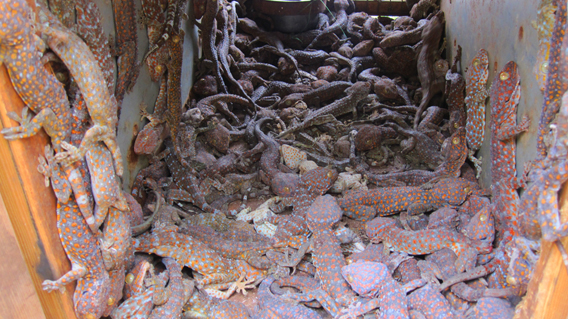 Over a thousand geckos discovered in the trunk of a taxi in Cambodia. Photo courtesy of Wildlife Alliance. Over a thousand tokay geckos (Gekko gecko) were found in a single trunk of a taxi by the Wildlife Rapid Response Team (WRRT), forestry officials, and military police in Cambodia. WRRT is wildlife-crimes program run by Wildlife […]
Over a thousand geckos discovered in the trunk of a taxi in Cambodia. Photo courtesy of Wildlife Alliance. Over a thousand tokay geckos (Gekko gecko) were found in a single trunk of a taxi by the Wildlife Rapid Response Team (WRRT), forestry officials, and military police in Cambodia. WRRT is wildlife-crimes program run by Wildlife […]
Customs officials confiscate over a thousand monitor lizards headed to China
 Thai Customs officials have confiscated 1,800 Bengal monitor lizards on the border between Thailand and Malaysia, reports the AFP. Officials said the lizards were likely headed to China for consumption. While Bengal monitor lizards (Varanus bengalensis) are listed as Least Concern by the IUCN Red List, global trade is banned by CITES and the species […]
Thai Customs officials have confiscated 1,800 Bengal monitor lizards on the border between Thailand and Malaysia, reports the AFP. Officials said the lizards were likely headed to China for consumption. While Bengal monitor lizards (Varanus bengalensis) are listed as Least Concern by the IUCN Red List, global trade is banned by CITES and the species […]
Malaysian customs seizes 1,800 trafficked reptiles
 Malaysia contains an amazing array of plants and animals, including this water monitor. Photo taken in Sabah by Rhett A. Butler Malaysia ended 2010 with the confiscation of 4.3 metric tons of reptiles near the Thai border on December 20th, reports the Wildlife Trade Monitoring Network, TRAFFIC. The confiscation was the largest of the year […]
Malaysia contains an amazing array of plants and animals, including this water monitor. Photo taken in Sabah by Rhett A. Butler Malaysia ended 2010 with the confiscation of 4.3 metric tons of reptiles near the Thai border on December 20th, reports the Wildlife Trade Monitoring Network, TRAFFIC. The confiscation was the largest of the year […]
Foto: Bunglon ‘Tarzan’ Ditemukan di Madagaskar
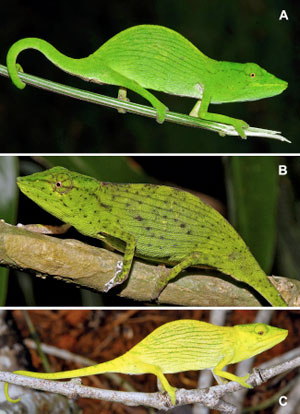 Temukan nama spesies untuk mempromosikan konservasi daripada mereka sendiri. Ilmuwan telah menemukan spesies baru dari bunglon di suatu blok kecil hutan hujan di Madagaskar. Kadal yang berubah warna ini, yang dituliskan dalam edisi terbaru dariSalamandra Journal, diberi nama Calumma tarzan sesuai kota Tarzanville didekatnya, di tengah dataran tinggi bagian timur Madagaskar. Bunglon ini biasanya bewarna […]
Temukan nama spesies untuk mempromosikan konservasi daripada mereka sendiri. Ilmuwan telah menemukan spesies baru dari bunglon di suatu blok kecil hutan hujan di Madagaskar. Kadal yang berubah warna ini, yang dituliskan dalam edisi terbaru dariSalamandra Journal, diberi nama Calumma tarzan sesuai kota Tarzanville didekatnya, di tengah dataran tinggi bagian timur Madagaskar. Bunglon ini biasanya bewarna […]
Photos: ‘Tarzan’ chameleon discovered in Madagascar
 Discovers name species to promote conservation rather than themselves. Scientists have discovered a new species of chameleon in a small block of rainforest in Madagascar. The color-changing lizard, which is described in the current issue of Salamandra Journal, is named Calumma tarzan after the nearby town of Tarzanville, in the central eastern highlands of Madagascar. […]
Discovers name species to promote conservation rather than themselves. Scientists have discovered a new species of chameleon in a small block of rainforest in Madagascar. The color-changing lizard, which is described in the current issue of Salamandra Journal, is named Calumma tarzan after the nearby town of Tarzanville, in the central eastern highlands of Madagascar. […]
Photos: rats drive island lizard to extinction
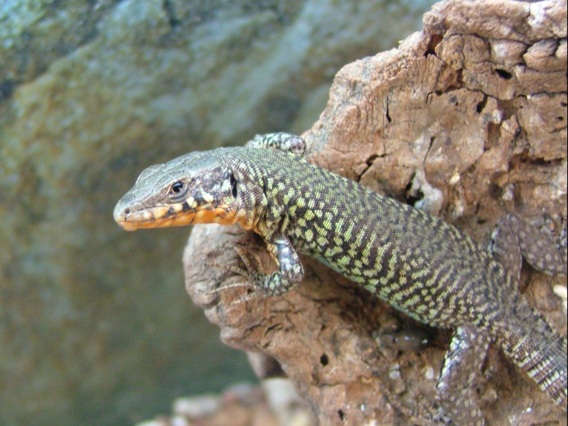 The Selmunett lizard (Podarcis filfolensis ssp. Kieselbachi) is very likely extinct, according to Maltese naturalist Arnold Sciberras. One of four subspecies of the Maltese wall lizard, the Selmunett lizard was last seen in 2005. Although the lizard’s home—Selmunett Island—has long been uninhabited by people, that fact did not help save the lizard. Over-predation by introduced […]
The Selmunett lizard (Podarcis filfolensis ssp. Kieselbachi) is very likely extinct, according to Maltese naturalist Arnold Sciberras. One of four subspecies of the Maltese wall lizard, the Selmunett lizard was last seen in 2005. Although the lizard’s home—Selmunett Island—has long been uninhabited by people, that fact did not help save the lizard. Over-predation by introduced […]
Climate change devastating lizards worldwide: 20 percent estimated to face extinction
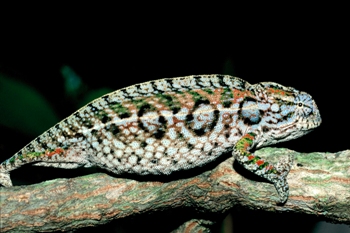 Lizards have evolved a variety of methods to escape predators: some will drop their tail if caught, many have coloring and patterning that blends in with their environment, a few have the ability to change their colors as their background changes, while a lot of them depend on bursts of speed to skitter away, but […]
Lizards have evolved a variety of methods to escape predators: some will drop their tail if caught, many have coloring and patterning that blends in with their environment, a few have the ability to change their colors as their background changes, while a lot of them depend on bursts of speed to skitter away, but […]
Photo: Fruit-eating dragon discovered in the Philippines
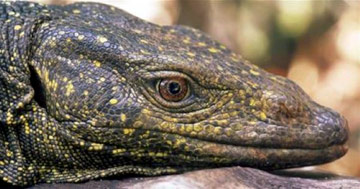 Scientists have discovered a new species of giant lizard in the unlikeliest of places: a highly populated, deforested landscape in the Philippines. The species, described in the journal Biology Letters, is named Varanus bitatawa and was discovered in river valley on northern Luzon Island, according to the AFP. The monitor lizard has survived habitat loss […]
Scientists have discovered a new species of giant lizard in the unlikeliest of places: a highly populated, deforested landscape in the Philippines. The species, described in the journal Biology Letters, is named Varanus bitatawa and was discovered in river valley on northern Luzon Island, according to the AFP. The monitor lizard has survived habitat loss […]
Photo: Camouflage expert discovered in Cambodia
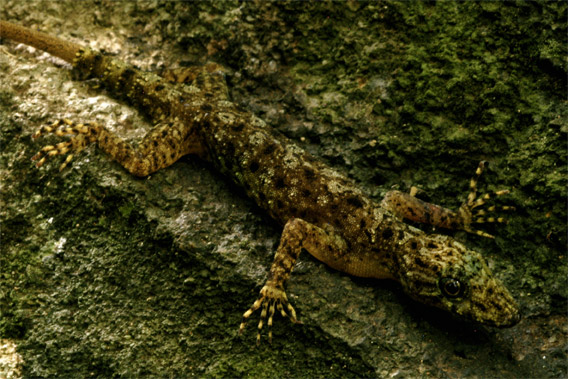 Researchers have discovered a cryptic species of gecko in the Cardamom Mountains of Cambodia, reports Fauna & Flora International (FFI), a conservation group that operates in the region. The new species, named Cnemaspis neangthyi after Neang Thy, a Cambodian conservationist, was first collected during a field survey led by Dr Lee Grismer of La Sierra […]
Researchers have discovered a cryptic species of gecko in the Cardamom Mountains of Cambodia, reports Fauna & Flora International (FFI), a conservation group that operates in the region. The new species, named Cnemaspis neangthyi after Neang Thy, a Cambodian conservationist, was first collected during a field survey led by Dr Lee Grismer of La Sierra […]
Gold mining threatens world’s most infamous reptile, the Komodo dragon
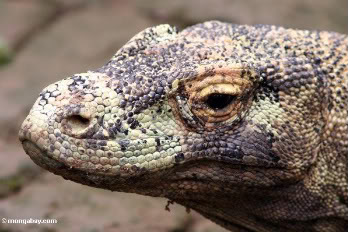
Photo: Scientists discover new species of Komodo dragon-like lizard
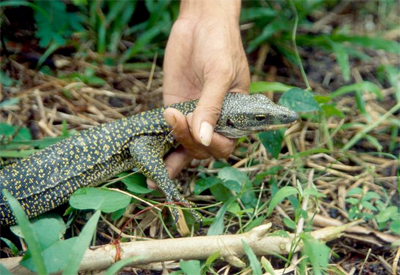 German researchers have discovered a new species of monitor lizard in Indonesia using DNA analysis and morphological characteristics. The species, Varanus lirungensis, is described in the Australian Journal of Zoology. Varanus lirungensis inhabits the Talaud Islands, an archipelago between the Indonesian island of Sulawesi and Mindanao in the Philippines. Its latin name refers to the […]
German researchers have discovered a new species of monitor lizard in Indonesia using DNA analysis and morphological characteristics. The species, Varanus lirungensis, is described in the Australian Journal of Zoology. Varanus lirungensis inhabits the Talaud Islands, an archipelago between the Indonesian island of Sulawesi and Mindanao in the Philippines. Its latin name refers to the […]
Photos: treasure trove of new species discovered in Ecuador
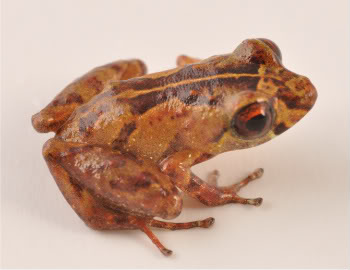 Near the once-contentious border of Ecuador and Peru in the mountainous forests of the Cordillera del Condor, scientists from Conservation International (CI) conducted a Rapid Assessment Program (RAP), uncovering what they believe are several new species, including four amphibians, one lizard, and seven insects. “The species that we discovered on this expedition are fascinating and […]
Near the once-contentious border of Ecuador and Peru in the mountainous forests of the Cordillera del Condor, scientists from Conservation International (CI) conducted a Rapid Assessment Program (RAP), uncovering what they believe are several new species, including four amphibians, one lizard, and seven insects. “The species that we discovered on this expedition are fascinating and […]
Komodo dragons are venomous
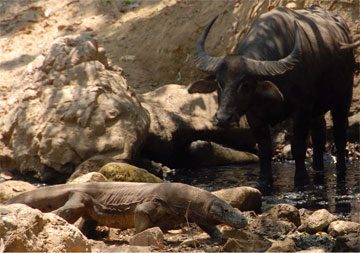 A new study has shown the world’s largest lizard to be poisonous The world’s largest lizard relies on venom to weaken and immobilize its prey, report researchers writing in Proceedings of the National Academy of Sciences. Until now it was believed that bacteria resident in the Komodo Dragon’s mouth were the source of the reptile’s […]
A new study has shown the world’s largest lizard to be poisonous The world’s largest lizard relies on venom to weaken and immobilize its prey, report researchers writing in Proceedings of the National Academy of Sciences. Until now it was believed that bacteria resident in the Komodo Dragon’s mouth were the source of the reptile’s […]
Fisherman killed by two Komodo dragons
 Mohamad Anwar, 32, was killed by two Komodo dragons after trespassing in Komodo National Park in order to gather fruit according to CNN. Anwar was declared dead on arrival to a clinic on Flore Island from loss of blood. While attacks by Komodo dragons, the world’s largest lizard, are rare, a series of recent attacks […]
Mohamad Anwar, 32, was killed by two Komodo dragons after trespassing in Komodo National Park in order to gather fruit according to CNN. Anwar was declared dead on arrival to a clinic on Flore Island from loss of blood. While attacks by Komodo dragons, the world’s largest lizard, are rare, a series of recent attacks […]
Climate change could devastate lizards in the tropics
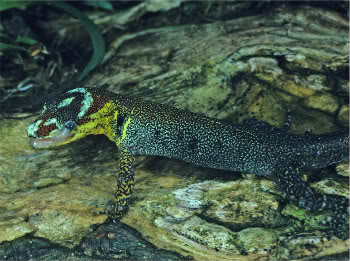
Unknown but critically endangered iguana species discovered in Fiji
Unknown but critically endangered iguana species discovered in Fiji Unknown but critically endangered iguana species discovered in Fiji mongabay.com September 19, 2008 Researchers have discovered a third species of iguana in Fiji. It is believed to be critically endangered, with a population of a “few hundred”. The bright green lizard, which reaches a length of […]
Komodo dragon conservation efforts prove controversial in Indonesia
 Komodo dragon conservation efforts prove controversial — and dangerous — in Indonesia Komodo dragon conservation efforts prove controversial in Indonesia mongabay.com August 25, 2008 Efforts to protect a giant reptile upset local humans. Efforts to conserve the world’s largest lizard — the Komodo dragon — are proving controversial, and potentially dangerous to villagers, reports the […]
Komodo dragon conservation efforts prove controversial — and dangerous — in Indonesia Komodo dragon conservation efforts prove controversial in Indonesia mongabay.com August 25, 2008 Efforts to protect a giant reptile upset local humans. Efforts to conserve the world’s largest lizard — the Komodo dragon — are proving controversial, and potentially dangerous to villagers, reports the […]
How falling a gecko lands on its feet
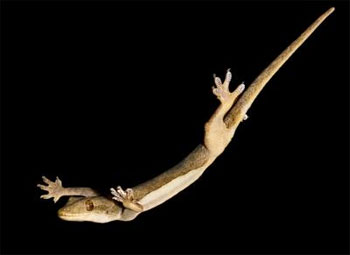 New research uncovers the super-tail of the gecko According to new research the gecko may have the most dynamic tail in the natural world. Two researchers from UC Berkley have discovered that the gecko uses its tail to keep itself from falling off slippery vertical surfaces and when falling to rapidly right itself. So, like […]
New research uncovers the super-tail of the gecko According to new research the gecko may have the most dynamic tail in the natural world. Two researchers from UC Berkley have discovered that the gecko uses its tail to keep itself from falling off slippery vertical surfaces and when falling to rapidly right itself. So, like […]
Photo of the Venomous Gila Monster Getting an X-ray
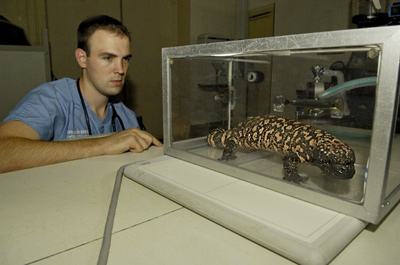 Photo of the Venomous Gila Monster Getting an X-ray Photo of the Venomous Gila Monster Getting an X-ray mongabay.com November 28, 2007 Dr. Tim Georoff, a veterinarian for the Wildlife Conservation Society’s Bronx Zoo, handles this venomous lizard with great care as he prepares this female for an radiograph (X-ray). The Plexiglass housing is part […]
Photo of the Venomous Gila Monster Getting an X-ray Photo of the Venomous Gila Monster Getting an X-ray mongabay.com November 28, 2007 Dr. Tim Georoff, a veterinarian for the Wildlife Conservation Society’s Bronx Zoo, handles this venomous lizard with great care as he prepares this female for an radiograph (X-ray). The Plexiglass housing is part […]
Iguanas listen to birds to avoid predators
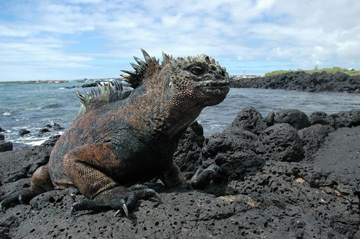 Iguanas listen to birds to avoid predators Galapagos Marine Iguanas eavesdrop on mockingbirds to avoid predation Jeremy Hance, special to mongabay.com October 29, 2007 As the world’s only sea-feeding lizard, Galapagos Marine Iguanas have long held a unique place in the animal kingdom. While most of their life is spent on land, these lizards forage […]
Iguanas listen to birds to avoid predators Galapagos Marine Iguanas eavesdrop on mockingbirds to avoid predation Jeremy Hance, special to mongabay.com October 29, 2007 As the world’s only sea-feeding lizard, Galapagos Marine Iguanas have long held a unique place in the animal kingdom. While most of their life is spent on land, these lizards forage […]
Forest disturbance reduces biodiversity in the Amazon rainforest
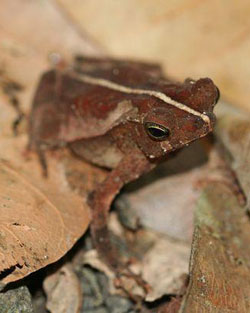 Primary rainforest richer in species than plantations, secondary forests Forest disturbance reduces biodiversity in the Amazon rainforest Primary rainforest richer in species than plantations, secondary forests Rhett A. Butler, mongabay.com July 2, 2007 Two new studies in the Amazon rainforest show that plantation forests and second-growth forests have lower species counts for butterflies, reptiles, and […]
Primary rainforest richer in species than plantations, secondary forests Forest disturbance reduces biodiversity in the Amazon rainforest Primary rainforest richer in species than plantations, secondary forests Rhett A. Butler, mongabay.com July 2, 2007 Two new studies in the Amazon rainforest show that plantation forests and second-growth forests have lower species counts for butterflies, reptiles, and […]
Feeds: news | india | latam | brasil | indonesia
 There is a longstanding disagreement amongst conservationists about whether or not it makes sense to focus efforts on protecting species that are popular with us Homo sapiens. Many argue that conserving the most imperiled species should be the priority, or that a species’ importance to the ecosystem in which it lives should be the decisive […]
There is a longstanding disagreement amongst conservationists about whether or not it makes sense to focus efforts on protecting species that are popular with us Homo sapiens. Many argue that conserving the most imperiled species should be the priority, or that a species’ importance to the ecosystem in which it lives should be the decisive […] Panther chameleon in Maroantsetra, Madagascar. Photos by Rhett A. Butler. The panther chameleon, a lizard prized in the pet trade for its remarkable color changing abilities, may actually represent 11 different species, report researchers writing in the journal Molecular Ecology. Analyzing the genetics of more than 300 individual panther chameleons, Swiss and Malagasy researchers make […]
Panther chameleon in Maroantsetra, Madagascar. Photos by Rhett A. Butler. The panther chameleon, a lizard prized in the pet trade for its remarkable color changing abilities, may actually represent 11 different species, report researchers writing in the journal Molecular Ecology. Analyzing the genetics of more than 300 individual panther chameleons, Swiss and Malagasy researchers make […] Monitor lizards, like this water monitor in Malaysia, are popular both in the pet trade and for consumption. Photo by Rhett A. Butler Searching the globe for undiscovered species takes biologists to far and remote locations, trekking through exotic locales that may yield a new discovery. However, exploring the black market can also produce results. […]
Monitor lizards, like this water monitor in Malaysia, are popular both in the pet trade and for consumption. Photo by Rhett A. Butler Searching the globe for undiscovered species takes biologists to far and remote locations, trekking through exotic locales that may yield a new discovery. However, exploring the black market can also produce results. […] Imitation can be obnoxious. For those with siblings, imitating your brother’s or sister’s every word was a surefire way to steadily drive them toward insanity. Annoying it may be, imitation is also special; it’s a behavior long regarded to be uniquely human. The skill of imitation is a little less exclusive now, as reptiles join […]
Imitation can be obnoxious. For those with siblings, imitating your brother’s or sister’s every word was a surefire way to steadily drive them toward insanity. Annoying it may be, imitation is also special; it’s a behavior long regarded to be uniquely human. The skill of imitation is a little less exclusive now, as reptiles join […] Sai Yok bent-toed gecko found on forested hill near Myanmar border, researchers think more species await discovery in biodiverse region A research team based in western Thailand has discovered a new gecko species in the Kanchanaburi Province, a region renowned for its number of species found nowhere else in the world. A recent publication in […]
Sai Yok bent-toed gecko found on forested hill near Myanmar border, researchers think more species await discovery in biodiverse region A research team based in western Thailand has discovered a new gecko species in the Kanchanaburi Province, a region renowned for its number of species found nowhere else in the world. A recent publication in […] Scientists propose expedition to find world’s rarest chameleon: Chapman’s pygmy chameleon A female Chapman’s pygmy chameleon (Rhampholeon chapmanorum
Scientists propose expedition to find world’s rarest chameleon: Chapman’s pygmy chameleon A female Chapman’s pygmy chameleon (Rhampholeon chapmanorum World’s chameleons facing potential extinction crisis The lesser chameleon (Furcifer minor) is listed as Endangered. This species is only found in Madagascar. Photo by: Christopher V. Anderson. Chameleons are an unmistakable family of wonderfully bizarre reptiles. They sport long, shooting tongues; oddly-shaped horns or crests; and a prehensile tail like a monkey’s. But, of course, […]
World’s chameleons facing potential extinction crisis The lesser chameleon (Furcifer minor) is listed as Endangered. This species is only found in Madagascar. Photo by: Christopher V. Anderson. Chameleons are an unmistakable family of wonderfully bizarre reptiles. They sport long, shooting tongues; oddly-shaped horns or crests; and a prehensile tail like a monkey’s. But, of course, […] Overfishing has pushed the Pacific bluefin tuna from Least Concern to Vulnerable on the IUCN Red List. Photo by: © Monterey Bay Aquarium – Randy Wilder. Today, 22,413 species are threatened with extinction, according to the most recent update of the IUCN Red List. This is a rise of 310 species from the last update […]
Overfishing has pushed the Pacific bluefin tuna from Least Concern to Vulnerable on the IUCN Red List. Photo by: © Monterey Bay Aquarium – Randy Wilder. Today, 22,413 species are threatened with extinction, according to the most recent update of the IUCN Red List. This is a rise of 310 species from the last update […] Juvenile and subadult of the new species Paroedura hordiesi. Credit: Jörn Köhler. Researchers have described a previously undocumented species of gecko in Madagascar. The species, named Paroedura hordiesi, lives among karst limestone massifs in the northern part of the Indian Ocean island nation. The lizard is notable for its skin pattern, which helps it blend […]
Juvenile and subadult of the new species Paroedura hordiesi. Credit: Jörn Köhler. Researchers have described a previously undocumented species of gecko in Madagascar. The species, named Paroedura hordiesi, lives among karst limestone massifs in the northern part of the Indian Ocean island nation. The lizard is notable for its skin pattern, which helps it blend […] An anole lizard silhouetted on a rainforest leaf. Photo by Rhett A. Butler. The biggest factor determining species diversity and distribution on islands is not size and isolation, as traditional island biogeography theory states, but economics. Simply put, the more trade an island is engaged in, the more boats visit it, and with more boats […]
An anole lizard silhouetted on a rainforest leaf. Photo by Rhett A. Butler. The biggest factor determining species diversity and distribution on islands is not size and isolation, as traditional island biogeography theory states, but economics. Simply put, the more trade an island is engaged in, the more boats visit it, and with more boats […] This potentially new lizard species was discovered on the last day of a survey in a cloud forest in Andean Peru. Photo: Luis Mamani. A group of Peruvian and Mexican scientists say they have uncovered at least six new species near South America’s most famous archaeological site: Machu Picchu. The discoveries include a new mammal, […]
This potentially new lizard species was discovered on the last day of a survey in a cloud forest in Andean Peru. Photo: Luis Mamani. A group of Peruvian and Mexican scientists say they have uncovered at least six new species near South America’s most famous archaeological site: Machu Picchu. The discoveries include a new mammal, […] The earless monitor lizard (Lanthanotus borneensis). Barely seen since its description in 1878, the species has suddenly become a victim of wildlife trafficking for the pet trade. Photo by: Indraneil Das. If you’ve never heard of the earless monitor lizard, you’re not alone: this little-known, cryptic lizard has long-escaped the attention of the larger public. […]
The earless monitor lizard (Lanthanotus borneensis). Barely seen since its description in 1878, the species has suddenly become a victim of wildlife trafficking for the pet trade. Photo by: Indraneil Das. If you’ve never heard of the earless monitor lizard, you’re not alone: this little-known, cryptic lizard has long-escaped the attention of the larger public. […] At around 7-8 cm long, the Mount Mabu pygmy chameleon (Rhampholeon maspictus) is a relatively large species. Its name comes from the Latin for ‘painted man’, reflecting the striking green, blue and yellow coloration of breeding males. Image credit: William R. Branch, caption courtesy of Fauna & Flora International Google Earth has spurred the discovery […]
At around 7-8 cm long, the Mount Mabu pygmy chameleon (Rhampholeon maspictus) is a relatively large species. Its name comes from the Latin for ‘painted man’, reflecting the striking green, blue and yellow coloration of breeding males. Image credit: William R. Branch, caption courtesy of Fauna & Flora International Google Earth has spurred the discovery […] A two inch long Alopoglossus viridiceps shade lizard. Photo by Torres-Carvajal Researchers have discovered a colorful lizard species in the cloud forests of northwestern Ecuador. The species, dubbed Alopoglossus viridiceps, is a type of shade lizard. It is described in a recent issue of the journal ZooKeys. Like other shade lizards, Alopoglossus viridiceps lives in […]
A two inch long Alopoglossus viridiceps shade lizard. Photo by Torres-Carvajal Researchers have discovered a colorful lizard species in the cloud forests of northwestern Ecuador. The species, dubbed Alopoglossus viridiceps, is a type of shade lizard. It is described in a recent issue of the journal ZooKeys. Like other shade lizards, Alopoglossus viridiceps lives in […] The Cape Melville leaf-tailed gecko (Saltuarius eximius) is one of the top ten new species from 2013. Photo by: Conrad Hoskin. Out of around 18,000 new species described and named last year, scientists have highlighted ten in an effort to raise awareness about the imperiled biodiversity around us. Each species—from a teddy-bear-like carnivore in the […]
The Cape Melville leaf-tailed gecko (Saltuarius eximius) is one of the top ten new species from 2013. Photo by: Conrad Hoskin. Out of around 18,000 new species described and named last year, scientists have highlighted ten in an effort to raise awareness about the imperiled biodiversity around us. Each species—from a teddy-bear-like carnivore in the […] Malaysia is set to lose ancient limestone formations to quarrying despite the discovery of new species of geckos in the area. The species are described by Dr. L. Lee Grismer from California’s La Sierra University in three studies recently published in the journal Zootaxa. One of Grismer’s discoveries, Cyrtodactylus metropolis, is the first endemic vertebrate […]
Malaysia is set to lose ancient limestone formations to quarrying despite the discovery of new species of geckos in the area. The species are described by Dr. L. Lee Grismer from California’s La Sierra University in three studies recently published in the journal Zootaxa. One of Grismer’s discoveries, Cyrtodactylus metropolis, is the first endemic vertebrate […] Male Potamites erythrocularis stream lizard. Photo by Alessandro Catenazzi. A ‘new’ species of lizard has been described from the cloud forests of Peru’s Manu National Park, reports SERNANP, the Peruvian National Park Service. Potamites erythrocularis, an aquatic lizard that lives in cold streams at an elevation of of 900-2000 meters, was discovered during herpetological studies […]
Male Potamites erythrocularis stream lizard. Photo by Alessandro Catenazzi. A ‘new’ species of lizard has been described from the cloud forests of Peru’s Manu National Park, reports SERNANP, the Peruvian National Park Service. Potamites erythrocularis, an aquatic lizard that lives in cold streams at an elevation of of 900-2000 meters, was discovered during herpetological studies […] Scientists have identified a new species of day gecko that is the largest in its genus (Cnemaspis) to be found in Sri Lanka. To date, it has been observed only within the Rammalakanda Reserve in southern Sri Lanka, an area spanning just 1,700 hectares, raising questions about the viability of this population and hence the […]
Scientists have identified a new species of day gecko that is the largest in its genus (Cnemaspis) to be found in Sri Lanka. To date, it has been observed only within the Rammalakanda Reserve in southern Sri Lanka, an area spanning just 1,700 hectares, raising questions about the viability of this population and hence the […] Innovation in Tropical Forest Conservation: Q&A with Corey Bradshaw Primary peat forest in Sumatra. Photo by Rhett A. Butler. Much of Dr. Corey Bradshaw’s work has a singular aim: to keep primary habitats and functioning ecosystems intact. According to Bradshaw, the existing system of carbon trading rules needs to be changed so that primary forests […]
Innovation in Tropical Forest Conservation: Q&A with Corey Bradshaw Primary peat forest in Sumatra. Photo by Rhett A. Butler. Much of Dr. Corey Bradshaw’s work has a singular aim: to keep primary habitats and functioning ecosystems intact. According to Bradshaw, the existing system of carbon trading rules needs to be changed so that primary forests […] Collared treerunner in Colombia. Photo by Rhett A. Butler Now, that’s a horse of a different color. Or, in this case, a lizard of another species—four species. Recent research suggests that the collared treerunner (Plica plica), previously thought of as one widespread species, is actually four distinct species inhabiting diverse geographical areas east of the […]
Collared treerunner in Colombia. Photo by Rhett A. Butler Now, that’s a horse of a different color. Or, in this case, a lizard of another species—four species. Recent research suggests that the collared treerunner (Plica plica), previously thought of as one widespread species, is actually four distinct species inhabiting diverse geographical areas east of the […] As temperatures increase worldwide due to anthropogenic climate change, scientists are scrambling to figure out if species will be able to survive rapidly warming ecosystems. A new study in Global Change Biology offers a little hope. Studying reptiles and amphibians in the Philippines, scientists say some of these species may be able to seek refuge […]
As temperatures increase worldwide due to anthropogenic climate change, scientists are scrambling to figure out if species will be able to survive rapidly warming ecosystems. A new study in Global Change Biology offers a little hope. Studying reptiles and amphibians in the Philippines, scientists say some of these species may be able to seek refuge […] Institutions and governments have been scanning human irises for years to verify one’s identity—Google has been using this method since 2011—but could iris-scanning be employed on other species as well? According to a new study in Amphibia-Reptila, the answer is “yes.” Scientists have recently employed iris scanning to visually distinguish individuals of an imperiled gecko […]
Institutions and governments have been scanning human irises for years to verify one’s identity—Google has been using this method since 2011—but could iris-scanning be employed on other species as well? According to a new study in Amphibia-Reptila, the answer is “yes.” Scientists have recently employed iris scanning to visually distinguish individuals of an imperiled gecko […] New leaf-tail gecko. Photo copyright Tim Laman / National Geographic Researchers from James Cook University and National Geographic discovered three new herp species — a cryptic leaf-tail gecko, a colorful skink, and a frog — during an expedition to northeastern Australia. The species are described in three papers published in October in the journal Zootaxa. […]
New leaf-tail gecko. Photo copyright Tim Laman / National Geographic Researchers from James Cook University and National Geographic discovered three new herp species — a cryptic leaf-tail gecko, a colorful skink, and a frog — during an expedition to northeastern Australia. The species are described in three papers published in October in the journal Zootaxa. […] Four previously unknown species of legless lizard have been described in California, report researchers from the University of California at Berkeley and Cal State-Fullerton. The species, all members of the Anniella genus, were hiding in plain site, living in marginal habitats that included “a vacant lot in downtown Bakersfield, among oil derricks in the lower […]
Four previously unknown species of legless lizard have been described in California, report researchers from the University of California at Berkeley and Cal State-Fullerton. The species, all members of the Anniella genus, were hiding in plain site, living in marginal habitats that included “a vacant lot in downtown Bakersfield, among oil derricks in the lower […] Before the arrival of humans—with their dogs, cats, and wild pigs—the northern Bahamian rock iguana ruled its home range, being pound-for-pound among the biggest land animals on the islands. In these ecosystems, the iguana’s were the mega-grazers, the bison and elk of the Caribbean one might say. But hunting by humans, invasive species, and habitat […]
Before the arrival of humans—with their dogs, cats, and wild pigs—the northern Bahamian rock iguana ruled its home range, being pound-for-pound among the biggest land animals on the islands. In these ecosystems, the iguana’s were the mega-grazers, the bison and elk of the Caribbean one might say. But hunting by humans, invasive species, and habitat […] Last Wednesday, bulldozers entered the Loma Charco Azul Biological Reserve (LCABR) in the Dominican Republic and began clearing vegetation for agricultural development. The move stunned local conservationists who had not been notified ahead of time of the project. Although Charco Azul Biological Reserve is home to a wealth of threatened species—including the world’s largest population […]
Last Wednesday, bulldozers entered the Loma Charco Azul Biological Reserve (LCABR) in the Dominican Republic and began clearing vegetation for agricultural development. The move stunned local conservationists who had not been notified ahead of time of the project. Although Charco Azul Biological Reserve is home to a wealth of threatened species—including the world’s largest population […] Illegally traded lizards (left to right): black tree monitor (Varanus beccarii), Reisinger’s tree monitor (Varanus reisingeri), emerald monitor (Varanus prasinus), and the blue-spotted tree monitor (Varanus macraei). Photo courtesy of Jessica Lyons. The world’s monitor lizards remind us that the world was once ruled by reptiles: this genus (Varanus) includes the world’s biggest lizards, such […]
Illegally traded lizards (left to right): black tree monitor (Varanus beccarii), Reisinger’s tree monitor (Varanus reisingeri), emerald monitor (Varanus prasinus), and the blue-spotted tree monitor (Varanus macraei). Photo courtesy of Jessica Lyons. The world’s monitor lizards remind us that the world was once ruled by reptiles: this genus (Varanus) includes the world’s biggest lizards, such […] Millions of tokay geckos continue to be traded for traditional medicine, despite waning belief that the colorful lizards are a cure for AIDS, reports a new study from TRAFFIC. The study found that a spike in tokay gecko demand due to rumors that it could cure HIV/AIDS was relatively short-lived, lasting from 2009 and early […]
Millions of tokay geckos continue to be traded for traditional medicine, despite waning belief that the colorful lizards are a cure for AIDS, reports a new study from TRAFFIC. The study found that a spike in tokay gecko demand due to rumors that it could cure HIV/AIDS was relatively short-lived, lasting from 2009 and early […] Parson’s chameleon in Madagascar Madagascar’s color-changing chameleons originated in Africa and crossed over to the island some 65 million years ago, concludes a study published this week in the Proceedings of the Royal Society B. The research, which is based on genetic analysis of 174 chameleon species, found that the ancestors of today’s chameleons crossed […]
Parson’s chameleon in Madagascar Madagascar’s color-changing chameleons originated in Africa and crossed over to the island some 65 million years ago, concludes a study published this week in the Proceedings of the Royal Society B. The research, which is based on genetic analysis of 174 chameleon species, found that the ancestors of today’s chameleons crossed […] New species of woodlizard: Enyalioides binzayedi. Photo by: P.J. Venegas. Scientists have discovered two new species of woodlizards from the Peruvian Amazon. Woodlizards, in the genus Enyalioides, are little-known reptiles with only 10 described species found in South and Central America. Described in a new paper in ZooKeys, both new woodlizards were found in Cordillera […]
New species of woodlizard: Enyalioides binzayedi. Photo by: P.J. Venegas. Scientists have discovered two new species of woodlizards from the Peruvian Amazon. Woodlizards, in the genus Enyalioides, are little-known reptiles with only 10 described species found in South and Central America. Described in a new paper in ZooKeys, both new woodlizards were found in Cordillera […] Green iguana in Colombia. Photo by Rhett A. Butler Nearly a fifth the planet’s reptiles are threatened with extinction, warns a new assessment published in the journal Biological Conservation. The analysis, carried out by experts with the Zoological Society of London (ZSL) and the IUCN Species Survival Commission (SSC), is based on the extinction risk […]
Green iguana in Colombia. Photo by Rhett A. Butler Nearly a fifth the planet’s reptiles are threatened with extinction, warns a new assessment published in the journal Biological Conservation. The analysis, carried out by experts with the Zoological Society of London (ZSL) and the IUCN Species Survival Commission (SSC), is based on the extinction risk […] Scientists have discovered a new population of the Belalanda chameleon (Furcifer belalandaensis), boosting hope for one of Madagascar’s rarest chameleons. While the species was known only from a handful of trees in two Malagasy villages, researchers from the University of Kent’s Durrell Institute of Conservation and Ecology (DICE) have discovered another population near a third […]
Scientists have discovered a new population of the Belalanda chameleon (Furcifer belalandaensis), boosting hope for one of Madagascar’s rarest chameleons. While the species was known only from a handful of trees in two Malagasy villages, researchers from the University of Kent’s Durrell Institute of Conservation and Ecology (DICE) have discovered another population near a third […] Sirenoscincus mobydick. Image courtesy of France’s National Centre for Scientific Research. An international team of scientists have described a bizarre new species of worm-like lizard that lives underground. Strangely, they named it the “Moby Dick” mermaid skink. The researchers chose Sirenoscincus mobydick for the lizard’s unusual appearance, which includes a complete absence of pigmentation, a […]
Sirenoscincus mobydick. Image courtesy of France’s National Centre for Scientific Research. An international team of scientists have described a bizarre new species of worm-like lizard that lives underground. Strangely, they named it the “Moby Dick” mermaid skink. The researchers chose Sirenoscincus mobydick for the lizard’s unusual appearance, which includes a complete absence of pigmentation, a […] Male Calotes bachae. Photo by Peter Geissler. German and Russian biologists have discovered a stunning new species of lizard in Vietnam. The species, dubbed Calotes bachae, is described in a recent issue of the journal Zootaxa. Calotes bachae is a type of agama, a group of lizards commonly known as “forest dragons.” It was described […]
Male Calotes bachae. Photo by Peter Geissler. German and Russian biologists have discovered a stunning new species of lizard in Vietnam. The species, dubbed Calotes bachae, is described in a recent issue of the journal Zootaxa. Calotes bachae is a type of agama, a group of lizards commonly known as “forest dragons.” It was described […] The critically endangered electric blue day gecko (Lygodactylus willoamsi) from Tanzania. This species is being bred in captivity — wild populations are suffering from habitat destruction and over-collection for the pet trade. Day geckos are the jewels of the gecko family. Unlike most geckos which are nocturnal and often cryptic in coloration, day geckos are […]
The critically endangered electric blue day gecko (Lygodactylus willoamsi) from Tanzania. This species is being bred in captivity — wild populations are suffering from habitat destruction and over-collection for the pet trade. Day geckos are the jewels of the gecko family. Unlike most geckos which are nocturnal and often cryptic in coloration, day geckos are […] Spotted hyena in the Masai Mara. Photo by: Rhett A. Butler. Animals of the Masai Mara is the first illustrated guidebook to the Masai Mara region along the Kenya and Tanzania border. This is the world famous region of wildebeest migrations, large felines, towering African elephants, fascinating cultures, and great flora and fauna diversity. This […]
Spotted hyena in the Masai Mara. Photo by: Rhett A. Butler. Animals of the Masai Mara is the first illustrated guidebook to the Masai Mara region along the Kenya and Tanzania border. This is the world famous region of wildebeest migrations, large felines, towering African elephants, fascinating cultures, and great flora and fauna diversity. This […] Researchers in Australia have described three new lizard species from the northwestern part of the continent. The new species — the Elegant Rainbow Skink (Carlia decora), the Orange-flanked Rainbow Skink (Carlia rubigo), and the Whitsunday Rainbow Skink (Carlia inconnexa) — are described in the journal Zootaxa. The species were identified after careful study of the […]
Researchers in Australia have described three new lizard species from the northwestern part of the continent. The new species — the Elegant Rainbow Skink (Carlia decora), the Orange-flanked Rainbow Skink (Carlia rubigo), and the Whitsunday Rainbow Skink (Carlia inconnexa) — are described in the journal Zootaxa. The species were identified after careful study of the […] Illegally traded lizards (left to right): black tree monitor (Varanus beccarii), Reisinger’s tree monitor (Varanus reisingeri), emerald monitor (Varanus prasinus), and the blue-spotted tree monitor (Varanus macraei). Photo courtesy of Jessica Lyons. Demand for exotic pets is driving the illegal harvest and trade of herpetofauna (reptiles and amphibians) in Indonesian New Guinea, according to a […]
Illegally traded lizards (left to right): black tree monitor (Varanus beccarii), Reisinger’s tree monitor (Varanus reisingeri), emerald monitor (Varanus prasinus), and the blue-spotted tree monitor (Varanus macraei). Photo courtesy of Jessica Lyons. Demand for exotic pets is driving the illegal harvest and trade of herpetofauna (reptiles and amphibians) in Indonesian New Guinea, according to a […] Blue iguana in Queen Elizabeth II Botanic Park. Photo by: Lhb1239. The wild blue iguana population has increased by at least 15 times in the last ten years, prompting the IUCN Red List to move the species from Critically Endangered to just Endangered. A targeted, ambitious conservation program, headed by the Blue Iguana Recovery Team, […]
Blue iguana in Queen Elizabeth II Botanic Park. Photo by: Lhb1239. The wild blue iguana population has increased by at least 15 times in the last ten years, prompting the IUCN Red List to move the species from Critically Endangered to just Endangered. A targeted, ambitious conservation program, headed by the Blue Iguana Recovery Team, […] Orange-tailed skink hatchlings meet their match in a matchstick. Photo courtesy of the Durrell Wildlife Conservation Trust (DWCT). Three female orange-tailed skinks skinks have produced 16 skink babies in just four months, according to the Durrell Wildlife Conservation Trust (DWCT), which is captive breeding the Critically Endangered species. The breeding efforts are all the more […]
Orange-tailed skink hatchlings meet their match in a matchstick. Photo courtesy of the Durrell Wildlife Conservation Trust (DWCT). Three female orange-tailed skinks skinks have produced 16 skink babies in just four months, according to the Durrell Wildlife Conservation Trust (DWCT), which is captive breeding the Critically Endangered species. The breeding efforts are all the more […] Baby Yemen chameleon. Photo courtesy of ZSL Whipsnade Zoo. Ten Yemen chameleons (Chamaeleo calyptratus) were recently born at the Zoological Society of London’s (ZSL) Whipsnade Zoo. A popular pet species, the chameleons, also known as veiled chameleons, still thrive in the mountainous wilds of Yemen and Saudi Arabia. It is listed as Least Concern by […]
Baby Yemen chameleon. Photo courtesy of ZSL Whipsnade Zoo. Ten Yemen chameleons (Chamaeleo calyptratus) were recently born at the Zoological Society of London’s (ZSL) Whipsnade Zoo. A popular pet species, the chameleons, also known as veiled chameleons, still thrive in the mountainous wilds of Yemen and Saudi Arabia. It is listed as Least Concern by […] Water monitor photographed in Sabah, on the island of Borneo. The monitor lizards is known as ‘biawak’ in Malay. Picture by Rhett A. Butler. The Southeast Asian water monitor (Varanus salvator macromaculatus) is distributed widely across Southeast Asia. Reaching a length of up to 3 meters (10 feet), the species is one of the largest […]
Water monitor photographed in Sabah, on the island of Borneo. The monitor lizards is known as ‘biawak’ in Malay. Picture by Rhett A. Butler. The Southeast Asian water monitor (Varanus salvator macromaculatus) is distributed widely across Southeast Asia. Reaching a length of up to 3 meters (10 feet), the species is one of the largest […] The new species of lizard, Cordylus marunguensi, from the Democratic Republic of Congo. Photo courtesy of Eli Greenbaum. A new lizard has been discovered in a war-torn area of the Democratic Republic of the Congo (DRC). According to a paper in the African Journal of Herpetology, the new species was found hiding under a rock […]
The new species of lizard, Cordylus marunguensi, from the Democratic Republic of Congo. Photo courtesy of Eli Greenbaum. A new lizard has been discovered in a war-torn area of the Democratic Republic of the Congo (DRC). According to a paper in the African Journal of Herpetology, the new species was found hiding under a rock […] New species: the Anguilla Bank skink. Photo by: Karl Questal. In a single paper in Zootaxa scientists have rewritten the current understanding of lizard biodiversity in the Caribbean. By going over museum specimens of skinks, scientists have discovered 24 new species and re-established nine species previously described species, long-thought invalid. The single paper has increased […]
New species: the Anguilla Bank skink. Photo by: Karl Questal. In a single paper in Zootaxa scientists have rewritten the current understanding of lizard biodiversity in the Caribbean. By going over museum specimens of skinks, scientists have discovered 24 new species and re-established nine species previously described species, long-thought invalid. The single paper has increased […] Trachylepis cristinae, a newly described skink that is only found on Abd Al Kuri Island. Photo by: Fabio Pupin. Few people have ever heard of the Socotra Archipelago even though, biologically-speaking, it is among the world’s most wondrous set of islands. Over one third of Socotra’s plants are found no-where else on Earth, i.e. endemic, […]
Trachylepis cristinae, a newly described skink that is only found on Abd Al Kuri Island. Photo by: Fabio Pupin. Few people have ever heard of the Socotra Archipelago even though, biologically-speaking, it is among the world’s most wondrous set of islands. Over one third of Socotra’s plants are found no-where else on Earth, i.e. endemic, […] The Bumblebee Gecko (Nactus kunan) from Manus Island off Papua New Guinea was discovered in 2010, and described as a new species in 2012. Photo by Robert Fisher of the U.S. Geological Survey Researchers from the Papua New Guinea National Museum and the U.S. Geological Survey have discovered a new species of gecko on an […]
The Bumblebee Gecko (Nactus kunan) from Manus Island off Papua New Guinea was discovered in 2010, and described as a new species in 2012. Photo by Robert Fisher of the U.S. Geological Survey Researchers from the Papua New Guinea National Museum and the U.S. Geological Survey have discovered a new species of gecko on an […] Juvenile Brookesia micra on match. Scientists have discovered four new species of super-tiny chameleons in Madagascar, according to a new paper in PLoS ONE. The smallest of the new species, Brookesia micra, is found only on the small island of Nosy Hara and has been dubbed the smallest chameleon in the world, measuring from nose […]
Juvenile Brookesia micra on match. Scientists have discovered four new species of super-tiny chameleons in Madagascar, according to a new paper in PLoS ONE. The smallest of the new species, Brookesia micra, is found only on the small island of Nosy Hara and has been dubbed the smallest chameleon in the world, measuring from nose […] A male Potamites montanicola, a new species of lizard discovered in the Peruvian Andes. Photo courtesy of German Chávez. Researchers have discovered a new species of lizard in the Peruvian Andes, whose males sport beautiful colors, according to a paper in ZooKeys. The highest-dwelling known species of the genus Potamites, the new lizard, dubbed Potamites […]
A male Potamites montanicola, a new species of lizard discovered in the Peruvian Andes. Photo courtesy of German Chávez. Researchers have discovered a new species of lizard in the Peruvian Andes, whose males sport beautiful colors, according to a paper in ZooKeys. The highest-dwelling known species of the genus Potamites, the new lizard, dubbed Potamites […] A new study in Biology Letters has found that warmer temperatures may make lizards smarter, even as past studies have linked a global decline in lizards to climate change. Looking at Australia’s Eastern three-lined skink (Bassiana duperreyi), researchers found that warm temperatures during incubation not only resulted in larger individuals (a result confirmed in previous […]
A new study in Biology Letters has found that warmer temperatures may make lizards smarter, even as past studies have linked a global decline in lizards to climate change. Looking at Australia’s Eastern three-lined skink (Bassiana duperreyi), researchers found that warm temperatures during incubation not only resulted in larger individuals (a result confirmed in previous […] Bloodied male green iguanas fight in Colombia. All photos by: Rhett A. Butler. Found throughout Central and South America and parts of the Caribbean, the green iguana (Iguana iguana) is a large, mostly herbivorous lizard. The species, which has not been evaluated by the IUCN Red List, is threatened by the pet trade, habitat loss, […]
Bloodied male green iguanas fight in Colombia. All photos by: Rhett A. Butler. Found throughout Central and South America and parts of the Caribbean, the green iguana (Iguana iguana) is a large, mostly herbivorous lizard. The species, which has not been evaluated by the IUCN Red List, is threatened by the pet trade, habitat loss, […] This interview is an excerpt from The WildLife with Laurel Neme, a program that explores the mysteries of the animal world through interviews with scientists and other wildlife investigators. “The WildLife” airs every Monday from 1-2 pm EST on WOMM-LP, 105.9 FM in Burlington, Vermont. You can livestream it at theradiator.org or download the podcast […]
This interview is an excerpt from The WildLife with Laurel Neme, a program that explores the mysteries of the animal world through interviews with scientists and other wildlife investigators. “The WildLife” airs every Monday from 1-2 pm EST on WOMM-LP, 105.9 FM in Burlington, Vermont. You can livestream it at theradiator.org or download the podcast […] The critically endangered radiated tortoise. All photos by Rhett Butler 40 percent of Madagascar’s terrestrial reptiles are threatened with extinction due to habitat loss and over-collection for the pet trade, reports the International Union for Conservation of Nature (IUCN) in its latest update of the Red List of Threatened Species. Experts from around the world […]
The critically endangered radiated tortoise. All photos by Rhett Butler 40 percent of Madagascar’s terrestrial reptiles are threatened with extinction due to habitat loss and over-collection for the pet trade, reports the International Union for Conservation of Nature (IUCN) in its latest update of the Red List of Threatened Species. Experts from around the world […] A blue anole on Gorgona Island, Colombia. Photo from Thomas Marent’s book, “Rainforest“. Used with permission. The blue anole is one of the world’s most spectacular reptiles. Found only on the island of Gorgona, the blue anole is so elusive and rare that scientists have been unable to give an estimate of its population. However […]
A blue anole on Gorgona Island, Colombia. Photo from Thomas Marent’s book, “Rainforest“. Used with permission. The blue anole is one of the world’s most spectacular reptiles. Found only on the island of Gorgona, the blue anole is so elusive and rare that scientists have been unable to give an estimate of its population. However […] Reptiles have long been thought to be dim-witted, but a new study in Biology Letters finds that the Puerto Rican anole, a type of lizard, can match birds in smarts. Using cognitive tests that have been previously used on birds, researchers with Duke University found that the lizards were capable of solving a problem they’ve […]
Reptiles have long been thought to be dim-witted, but a new study in Biology Letters finds that the Puerto Rican anole, a type of lizard, can match birds in smarts. Using cognitive tests that have been previously used on birds, researchers with Duke University found that the lizards were capable of solving a problem they’ve […] This male Panther Chameleon, originating from Nosy Mangabe, Madagascar, was observed at a dealer’s house in Saraburi city, Thailand, January 2010. © M Todd/TRAFFIC. Conservation group TRAFFIC uncovered nearly 600 Madagascar reptiles and amphibians on sale in Thai markets, including endangered species and those banned for sale by the Convention on International Trade in Endangered […]
This male Panther Chameleon, originating from Nosy Mangabe, Madagascar, was observed at a dealer’s house in Saraburi city, Thailand, January 2010. © M Todd/TRAFFIC. Conservation group TRAFFIC uncovered nearly 600 Madagascar reptiles and amphibians on sale in Thai markets, including endangered species and those banned for sale by the Convention on International Trade in Endangered […] This commentary original appeared at the Jakarta Globe as Where Have All the Geckos Gone? and has been posted here with the permission of the authors. The call of the tokek, or gecko, is one of the most familiar sounds in Indonesia. Next to the smell of clove cigarettes, the calls to prayer, the friendly […]
This commentary original appeared at the Jakarta Globe as Where Have All the Geckos Gone? and has been posted here with the permission of the authors. The call of the tokek, or gecko, is one of the most familiar sounds in Indonesia. Next to the smell of clove cigarettes, the calls to prayer, the friendly […] A great desert skinks popping out of its burrow. Photo by: Adam Stow, Macquarie University. Researchers from Macquarie University in Australia have discovered that the threatened great desert burrowing skink lizard forms stable families that construct and maintain elaborate underground homes, reports ABC News. This is the first lizard in the world known to practice […]
A great desert skinks popping out of its burrow. Photo by: Adam Stow, Macquarie University. Researchers from Macquarie University in Australia have discovered that the threatened great desert burrowing skink lizard forms stable families that construct and maintain elaborate underground homes, reports ABC News. This is the first lizard in the world known to practice […] The newly discovered Dalai Mountain blind lizard (Dibamus dalaiensis). Photo courtesy of Fauna & Flora International. A new species of legless lizard has been discovered in Cambodia. Herpetologist Neang Thy uncovered, literally, the new species when he turned over a log in the species-rich Cardamom Mountains. While the new lizard looks like a snake or […]
The newly discovered Dalai Mountain blind lizard (Dibamus dalaiensis). Photo courtesy of Fauna & Flora International. A new species of legless lizard has been discovered in Cambodia. Herpetologist Neang Thy uncovered, literally, the new species when he turned over a log in the species-rich Cardamom Mountains. While the new lizard looks like a snake or […] Over a thousand geckos discovered in the trunk of a taxi in Cambodia. Photo courtesy of Wildlife Alliance. Over a thousand tokay geckos (Gekko gecko) were found in a single trunk of a taxi by the Wildlife Rapid Response Team (WRRT), forestry officials, and military police in Cambodia. WRRT is wildlife-crimes program run by Wildlife […]
Over a thousand geckos discovered in the trunk of a taxi in Cambodia. Photo courtesy of Wildlife Alliance. Over a thousand tokay geckos (Gekko gecko) were found in a single trunk of a taxi by the Wildlife Rapid Response Team (WRRT), forestry officials, and military police in Cambodia. WRRT is wildlife-crimes program run by Wildlife […] Thai Customs officials have confiscated 1,800 Bengal monitor lizards on the border between Thailand and Malaysia, reports the AFP. Officials said the lizards were likely headed to China for consumption. While Bengal monitor lizards (Varanus bengalensis) are listed as Least Concern by the IUCN Red List, global trade is banned by CITES and the species […]
Thai Customs officials have confiscated 1,800 Bengal monitor lizards on the border between Thailand and Malaysia, reports the AFP. Officials said the lizards were likely headed to China for consumption. While Bengal monitor lizards (Varanus bengalensis) are listed as Least Concern by the IUCN Red List, global trade is banned by CITES and the species […] Temukan nama spesies untuk mempromosikan konservasi daripada mereka sendiri. Ilmuwan telah menemukan spesies baru dari bunglon di suatu blok kecil hutan hujan di Madagaskar. Kadal yang berubah warna ini, yang dituliskan dalam edisi terbaru dariSalamandra Journal, diberi nama Calumma tarzan sesuai kota Tarzanville didekatnya, di tengah dataran tinggi bagian timur Madagaskar. Bunglon ini biasanya bewarna […]
Temukan nama spesies untuk mempromosikan konservasi daripada mereka sendiri. Ilmuwan telah menemukan spesies baru dari bunglon di suatu blok kecil hutan hujan di Madagaskar. Kadal yang berubah warna ini, yang dituliskan dalam edisi terbaru dariSalamandra Journal, diberi nama Calumma tarzan sesuai kota Tarzanville didekatnya, di tengah dataran tinggi bagian timur Madagaskar. Bunglon ini biasanya bewarna […] Discovers name species to promote conservation rather than themselves. Scientists have discovered a new species of chameleon in a small block of rainforest in Madagascar. The color-changing lizard, which is described in the current issue of Salamandra Journal, is named Calumma tarzan after the nearby town of Tarzanville, in the central eastern highlands of Madagascar. […]
Discovers name species to promote conservation rather than themselves. Scientists have discovered a new species of chameleon in a small block of rainforest in Madagascar. The color-changing lizard, which is described in the current issue of Salamandra Journal, is named Calumma tarzan after the nearby town of Tarzanville, in the central eastern highlands of Madagascar. […] The Selmunett lizard (Podarcis filfolensis ssp. Kieselbachi) is very likely extinct, according to Maltese naturalist Arnold Sciberras. One of four subspecies of the Maltese wall lizard, the Selmunett lizard was last seen in 2005. Although the lizard’s home—Selmunett Island—has long been uninhabited by people, that fact did not help save the lizard. Over-predation by introduced […]
The Selmunett lizard (Podarcis filfolensis ssp. Kieselbachi) is very likely extinct, according to Maltese naturalist Arnold Sciberras. One of four subspecies of the Maltese wall lizard, the Selmunett lizard was last seen in 2005. Although the lizard’s home—Selmunett Island—has long been uninhabited by people, that fact did not help save the lizard. Over-predation by introduced […] Lizards have evolved a variety of methods to escape predators: some will drop their tail if caught, many have coloring and patterning that blends in with their environment, a few have the ability to change their colors as their background changes, while a lot of them depend on bursts of speed to skitter away, but […]
Lizards have evolved a variety of methods to escape predators: some will drop their tail if caught, many have coloring and patterning that blends in with their environment, a few have the ability to change their colors as their background changes, while a lot of them depend on bursts of speed to skitter away, but […] Scientists have discovered a new species of giant lizard in the unlikeliest of places: a highly populated, deforested landscape in the Philippines. The species, described in the journal Biology Letters, is named Varanus bitatawa and was discovered in river valley on northern Luzon Island, according to the AFP. The monitor lizard has survived habitat loss […]
Scientists have discovered a new species of giant lizard in the unlikeliest of places: a highly populated, deforested landscape in the Philippines. The species, described in the journal Biology Letters, is named Varanus bitatawa and was discovered in river valley on northern Luzon Island, according to the AFP. The monitor lizard has survived habitat loss […] Researchers have discovered a cryptic species of gecko in the Cardamom Mountains of Cambodia, reports Fauna & Flora International (FFI), a conservation group that operates in the region. The new species, named Cnemaspis neangthyi after Neang Thy, a Cambodian conservationist, was first collected during a field survey led by Dr Lee Grismer of La Sierra […]
Researchers have discovered a cryptic species of gecko in the Cardamom Mountains of Cambodia, reports Fauna & Flora International (FFI), a conservation group that operates in the region. The new species, named Cnemaspis neangthyi after Neang Thy, a Cambodian conservationist, was first collected during a field survey led by Dr Lee Grismer of La Sierra […]
 German researchers have discovered a new species of monitor lizard in Indonesia using DNA analysis and morphological characteristics. The species, Varanus lirungensis, is described in the Australian Journal of Zoology. Varanus lirungensis inhabits the Talaud Islands, an archipelago between the Indonesian island of Sulawesi and Mindanao in the Philippines. Its latin name refers to the […]
German researchers have discovered a new species of monitor lizard in Indonesia using DNA analysis and morphological characteristics. The species, Varanus lirungensis, is described in the Australian Journal of Zoology. Varanus lirungensis inhabits the Talaud Islands, an archipelago between the Indonesian island of Sulawesi and Mindanao in the Philippines. Its latin name refers to the […] Near the once-contentious border of Ecuador and Peru in the mountainous forests of the Cordillera del Condor, scientists from Conservation International (CI) conducted a Rapid Assessment Program (RAP), uncovering what they believe are several new species, including four amphibians, one lizard, and seven insects. “The species that we discovered on this expedition are fascinating and […]
Near the once-contentious border of Ecuador and Peru in the mountainous forests of the Cordillera del Condor, scientists from Conservation International (CI) conducted a Rapid Assessment Program (RAP), uncovering what they believe are several new species, including four amphibians, one lizard, and seven insects. “The species that we discovered on this expedition are fascinating and […] A new study has shown the world’s largest lizard to be poisonous The world’s largest lizard relies on venom to weaken and immobilize its prey, report researchers writing in Proceedings of the National Academy of Sciences. Until now it was believed that bacteria resident in the Komodo Dragon’s mouth were the source of the reptile’s […]
A new study has shown the world’s largest lizard to be poisonous The world’s largest lizard relies on venom to weaken and immobilize its prey, report researchers writing in Proceedings of the National Academy of Sciences. Until now it was believed that bacteria resident in the Komodo Dragon’s mouth were the source of the reptile’s […] Mohamad Anwar, 32, was killed by two Komodo dragons after trespassing in Komodo National Park in order to gather fruit according to CNN. Anwar was declared dead on arrival to a clinic on Flore Island from loss of blood. While attacks by Komodo dragons, the world’s largest lizard, are rare, a series of recent attacks […]
Mohamad Anwar, 32, was killed by two Komodo dragons after trespassing in Komodo National Park in order to gather fruit according to CNN. Anwar was declared dead on arrival to a clinic on Flore Island from loss of blood. While attacks by Komodo dragons, the world’s largest lizard, are rare, a series of recent attacks […]
 Komodo dragon conservation efforts prove controversial — and dangerous — in Indonesia Komodo dragon conservation efforts prove controversial in Indonesia mongabay.com August 25, 2008 Efforts to protect a giant reptile upset local humans. Efforts to conserve the world’s largest lizard — the Komodo dragon — are proving controversial, and potentially dangerous to villagers, reports the […]
Komodo dragon conservation efforts prove controversial — and dangerous — in Indonesia Komodo dragon conservation efforts prove controversial in Indonesia mongabay.com August 25, 2008 Efforts to protect a giant reptile upset local humans. Efforts to conserve the world’s largest lizard — the Komodo dragon — are proving controversial, and potentially dangerous to villagers, reports the […] New research uncovers the super-tail of the gecko According to new research the gecko may have the most dynamic tail in the natural world. Two researchers from UC Berkley have discovered that the gecko uses its tail to keep itself from falling off slippery vertical surfaces and when falling to rapidly right itself. So, like […]
New research uncovers the super-tail of the gecko According to new research the gecko may have the most dynamic tail in the natural world. Two researchers from UC Berkley have discovered that the gecko uses its tail to keep itself from falling off slippery vertical surfaces and when falling to rapidly right itself. So, like […] Photo of the Venomous Gila Monster Getting an X-ray Photo of the Venomous Gila Monster Getting an X-ray mongabay.com November 28, 2007 Dr. Tim Georoff, a veterinarian for the Wildlife Conservation Society’s Bronx Zoo, handles this venomous lizard with great care as he prepares this female for an radiograph (X-ray). The Plexiglass housing is part […]
Photo of the Venomous Gila Monster Getting an X-ray Photo of the Venomous Gila Monster Getting an X-ray mongabay.com November 28, 2007 Dr. Tim Georoff, a veterinarian for the Wildlife Conservation Society’s Bronx Zoo, handles this venomous lizard with great care as he prepares this female for an radiograph (X-ray). The Plexiglass housing is part […] Iguanas listen to birds to avoid predators Galapagos Marine Iguanas eavesdrop on mockingbirds to avoid predation Jeremy Hance, special to mongabay.com October 29, 2007 As the world’s only sea-feeding lizard, Galapagos Marine Iguanas have long held a unique place in the animal kingdom. While most of their life is spent on land, these lizards forage […]
Iguanas listen to birds to avoid predators Galapagos Marine Iguanas eavesdrop on mockingbirds to avoid predation Jeremy Hance, special to mongabay.com October 29, 2007 As the world’s only sea-feeding lizard, Galapagos Marine Iguanas have long held a unique place in the animal kingdom. While most of their life is spent on land, these lizards forage […] Primary rainforest richer in species than plantations, secondary forests Forest disturbance reduces biodiversity in the Amazon rainforest Primary rainforest richer in species than plantations, secondary forests Rhett A. Butler, mongabay.com July 2, 2007 Two new studies in the Amazon rainforest show that plantation forests and second-growth forests have lower species counts for butterflies, reptiles, and […]
Primary rainforest richer in species than plantations, secondary forests Forest disturbance reduces biodiversity in the Amazon rainforest Primary rainforest richer in species than plantations, secondary forests Rhett A. Butler, mongabay.com July 2, 2007 Two new studies in the Amazon rainforest show that plantation forests and second-growth forests have lower species counts for butterflies, reptiles, and […]